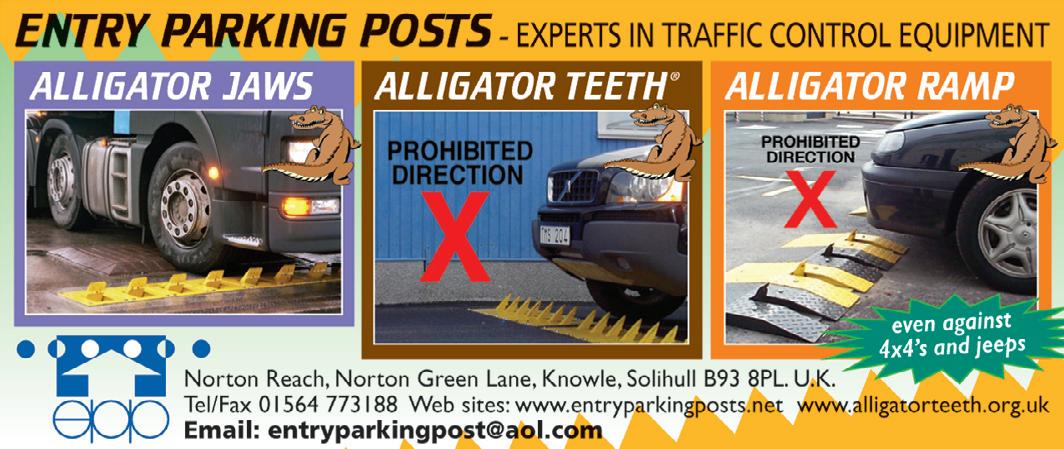






HGV


One thing that became clear during the pandemic was that logistics is vital to the wellbeing of the country’s economic health. Contemporary society is dependent on the smooth and reliable flow of goods and services, meaning we are dependent on delivery vehicles arriving where and when expected. This makes the management of deliveries to and from depots, stores, high streets, hospitals, building sites and factories an important task. The traffic and parking sector plays a key role in ensuring logistics functions by providing access to town centres and the kerbside. There is much good work being done on improving the management of loading and unloading in town and city centres, including the development of systems that allow the pre-booking of delivery slots. And concepts such as transhipment and service hubs are being investigated as a means of improving the last-mile of delivery runs.
But we also need to look at the many miles that are covered before the last one. When it comes to the provision of places for heavy goods vehicles (HGVs) to park up while making journeys much work needs to be done. The UK lacks adequate overnight lorry parking, as is underlined in the National Survey of Lorry Parking 2022, produced by consultant AECOM for the Department for Transport. Things must change. There is an urgent need for more lorry parking providing affordable refreshment and rest areas. As part of a HGV drivers’ focus group undertaken for the AECOM study, the standard of on-site parking facilities such as showers, good food, available spaces to park, social spaces, and cost of parking were highlighted as areas of concern and that if addressed would benefit driver recruitment and retention. It also appears 60% of drivers feel they do not get enough money to cover the cost of parking.
The planning process takes time, so maybe existing provision can be better utilised. Coach and car parking areas in motorway service areas (MSAs) are often under-utilised during the evening and at nights. Maybe MSAs could be provided as additional spaces for lorries without the need to extend the site, although facilities may need upgrading to accommodate lorry drivers. The 2022 national audit also found the use of apps, booking tools and on-site traffic marshals are all ways of making better use of the spaces available around the country. This suggests there are business opportunities for the parking sector.
Mark Moran Editor

60% of
drivers do not get enough money to cover the cost of parking Smarter
Provide your customers with the best-in-class payment solutions on-site and incorporate the leading options for digital payments at the same time.
You can be confident when investing in WPS that you are providing the widest choice of payment choices to your customers with an industry-leading redesigned user interface.
Digital payments, pre-booking and permit systems are ready to go using our partners JustPark and ZatPark, with RingGo launching soon or using our own payment app, WPS Pay.
WPS are also proud to be leading the way with confirmed integration into the new National Parking Platform (NPP).
Build your parking operation on the WPS Parking platform and our ever growing Marketplace of integrated solutions.


Editorial Managing editor:
Mark Moran
Tel: 020 7091 7871

mark.moran@landor.co.uk
Deputy editor: Deniz Huseyin

Tel: 020 7091 7872
deniz.huseyin@landor.co.uk
Production

production@landor.co.uk
Accounts
jason@landor.co.uk Subscriptions


Irina Cocks Tel: 020 7091 7854
irina.cocks@landor.co.uk
Managing Director
0962

people learn more about the areas they live in. The plotter takes account of communities that have the least access to green space and areas that experience high levels of social deprivation.
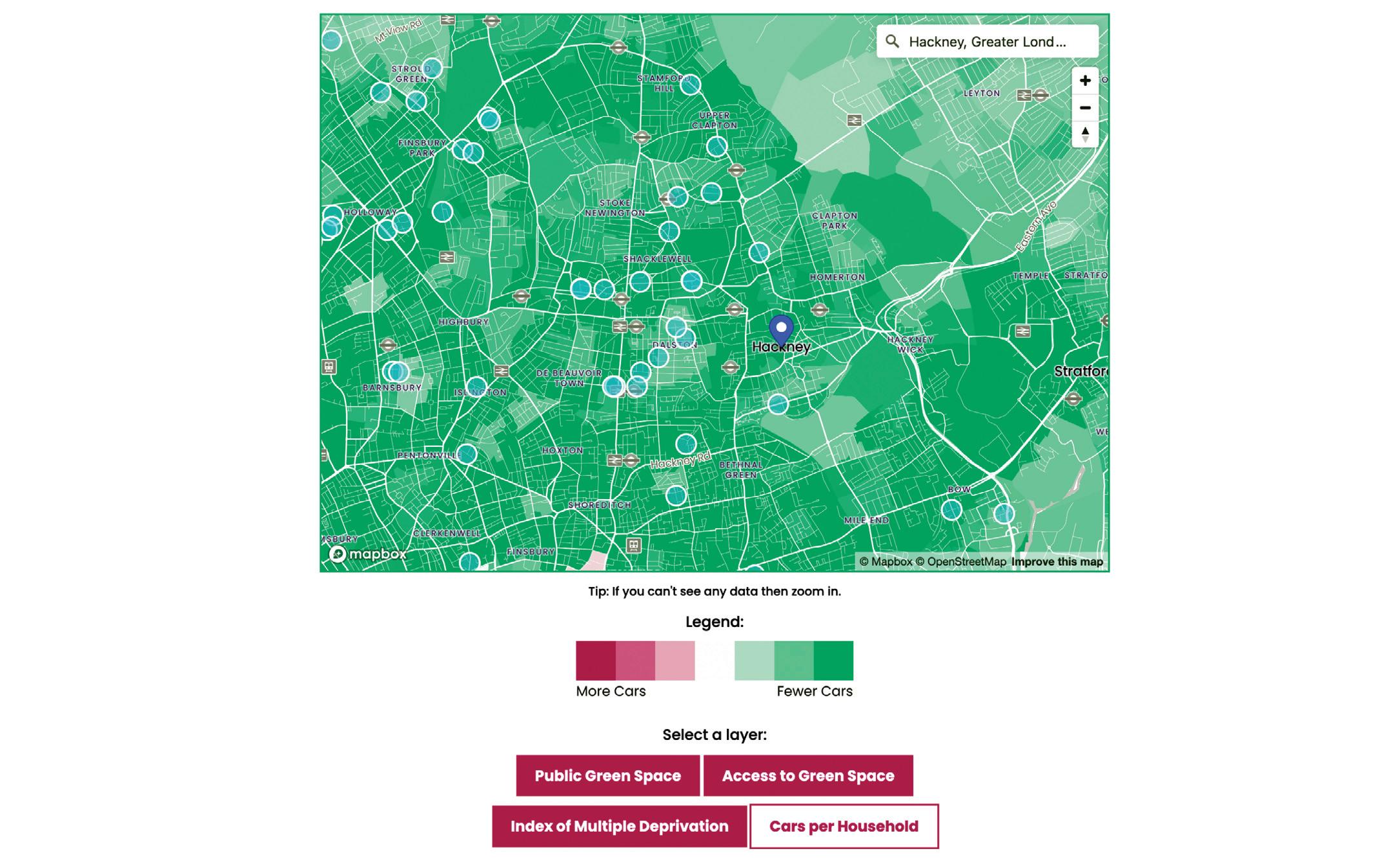
Parklets show what cities could look like if they were designed for the needs of the people who live in them rather than the car, argues climate change charity Possible. The charity enables people to organise local actions to inspire a more ambitious approach at every level of society. Founded as 10:10 Action in 2009, the organisation began by campaigning for a 10% reduction in carbon emissions in 2010. It has since broadened its approach to promote a range of projects focussed on carbon reduction and renewable energy.
In 2021, the charity launched Car Free Cities, a campaign seeking to address car dominance in four UK cities: Birmingham, Bristol, Leeds and London. The campaign aims to help local communities reimagine their own neighbourhoods where car dependency is a thing of the past; and to co-design and deliver practical grassroots solutions that reduce motor traffic dominance.

To mark Car Free Day 2022, Possible’s Car Free Cities team created pop-up parklets in Birmingham, Bristol, Leeds and London to show alternative uses for parking spaces.
Possible states: “A parklet is a reclaimed parking space that has been transformed into a space that everyone can enjoy. It can be a place to rest and relax, or play and socialise. It can bring communities together, providing much-needed outdoor green space. The possibilities are endless.”
The charity’s vision of a “car free city” is of a place free of the dangers, pollution, and emissions caused by mass private car ownership. However, is would not be a city with no cars at all. Possible says many people, including disabled people, cannot get around without a car, and the charity’s efforts to reduce the number of cars in cities hopes to make their lives easier.
Possible has devised a design tool for people to create their own parklet and the Parklet Plotter, an interactive map that helps
“Local residents must be actively involved and engaged in the process of reclaiming and reimagining the streets they live in,” the campaign says. “Therefore, councils across the country must establish a simple process that lets residents create their own permanent community parklets.”

Possible says: “In a world recovering from a global health crisis whilst also tackling the climate crisis; green space, and access to it, has never been more important. Green spaces help clean our air and cool us down. Being outside in nature fosters happiness and social connection, and can improve our health and wellbeing. But not everyone has the same access to adequate green space.”
Possible encourages people to contact their local councillors to demonstrate how streets can be improved by converting parking spaces into parklets. Possible is calling for councils to set up a simple process that allows residents transform their streets. www.wearepossible.org
Parking spaces across Hounslow in west London could soon be given a new lease of life as miniature meeting points for all of the community. The repurposed bays – known as parklets – are part of Hounslow Council’s strategy to bring greater variety of social activity to the borough’s streets by ensuring there is space for everyone, not just vehicles.
On-street bays that meet the right criteria, could be transformed into al-fresco seating, spaces to play board games, focal points for community activity or simply somewhere to sit, meet and watch the world go by.
Hounslow’s cabinet members have approved the plans, which means community groups, organisations and local businesses can now bid to create their own community parklets.
A report to cabinet about the parklets project said: “We are committed to enhancing public realm design so that our streets can better support active travel. Nearly one third of our households don’t have access to a vehicle, yet the kerbside remains dominated by parking. Any opportunity to allow flexibility in the use of kerbside space, other than car storage, will enable us to improve the public realm for our residents.
“Parklets repurpose a parking space on the street for uses other than the parking of cars. They can include planters, benches, games, notice boards, phone charging facilities or any other items that residents or businesses propose.”
Under the scheme, anyone who wants a parklet will have to submit an application form. Groups will have to prove how they can fully fund, fit-out and provide on-going maintenance of the parklet throughout its lifespan.
Those proposing parklets will also need to provide public liability insurance for the space, prove that they have consulted and have agreement with the community and there is a genuine desire for the parklet.
Council officers will scrutinise each application and if the schemes meet the necessary criteria, they will be approved for a six-month trial period. The parklet will be reviewed at the end of the trial period and officers will decide whether it can become a permanent fixture.
Hounslow Council’s deputy leader and cabinet member for climate, environment and transport strategy, Cllr Katherine Dunne, said: “We want to make sure that everyone in our borough can take advantage of an outdoor space. At the same time, we want to reduce the dominance of cars on our roads. We need to reduce congestion on our borough’s road, improve air quality for everyone and rise to the challenges of climate change. The COVID-19 pandemic placed greater emphasis on active travel and the need for outdoor communal spaces.
“We want to work with our communities and help them to provide spaces that will bring people together and support local businesses. Creating and maintaining a parklet will require hard work and commitment. We can support anyone who wants to make an application with information and guidance. These green community spaces have proved popular in other boroughs across London and across the country.”

Bicycle manufacturer Brompton transformed a dilapidated petrol station in London last month to mark World Car Free Day 2022. A petrol station, near Elephant and Castle, was given a 24-hour revamp including test ride and track facilities for both standard and electric Bromptons, a Brompton Bike Hire dock, artwork, parklets and green space and a consultation station with climate change charity Possible. The firm used the event to highlight changes to its bike hire offer, with a new daily hire charge of £5 a day, with no joining fees.
World Car Free Day, held on 22 September, is an opportunity for towns and cities around the world to enable people to experience streets free of motor traffic and re-imagine their local environment.
Will Butler-Adams, chief executive of Brompton Bicycle, said: ‘’For too long, our cities have been dominated by the most inefficient mode of transport – the private car. At Brompton, we have long sought to highlight the benefits that increased levels of cycling and walking would bring to society.

‘’What better way to do that, than to totally re-imagine a space formerly used as a petrol station. Our cities have changed and are continuing to change. We hope that turning a dilapidated old petrol station into a green transport hub will show people what’s possible when it comes to their own perception of what cities are for.”
Will Norman, walking and cycling commissioner for London said: ‘’With the realities of the impacts of climate change becoming ever clearer, it has never been more important to re-imagine how we move around our cities. Car Free Day gives us an opportunity to do just that, and experience streets which prioritise people over cars.”
Hackney Council in east London says the introduction of three new parklets reaffirms its ongoing commitment to reclaim road space from motor vehicles and rebuild a greener borough in the aftermath of the pandemic. The parklets have been installed on Wilton Way, “radically repurposing” car parking spaces into green sitting areas.
Each parklet consists of a wooden platform and planters, with local businesses providing seating during the day. While they are used and maintained by businesses, the parklets are funded by the council and available for passers-by to use.
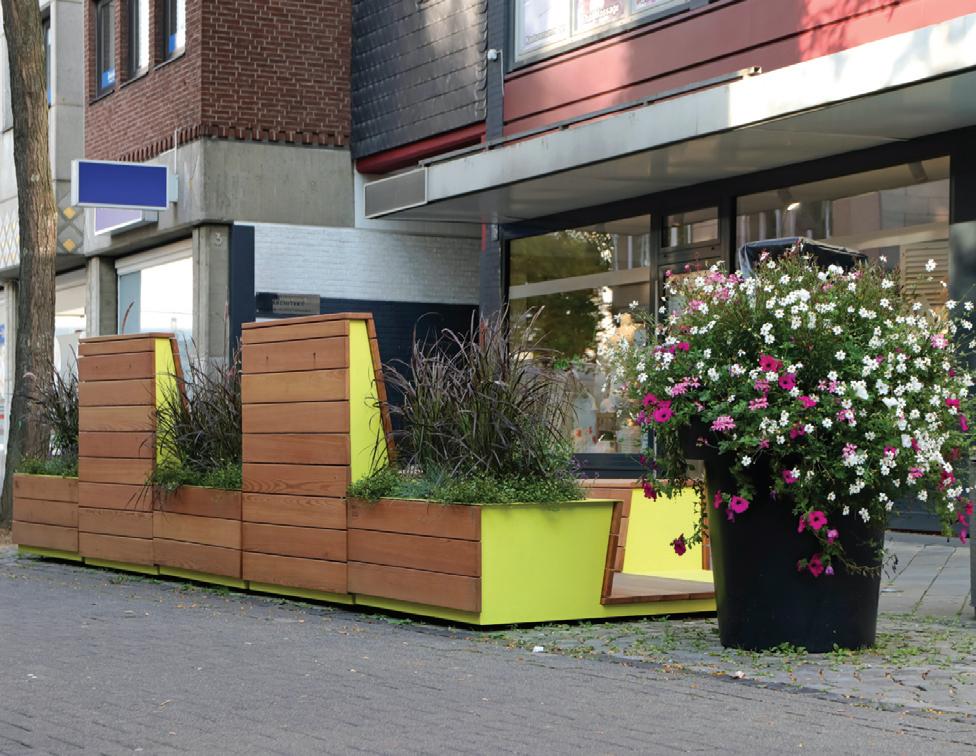
Two new cycle parking parklets with shrubs and trees will also provide more bike spaces and greenery on the street.
Philip Glanville, mayor of Hackney, said: “Seven in 10 Hackney households do not own a car, which is why we’re passionate about reclaiming space from motor vehicles for everyone. “Not only do these parklets give people somewhere to sit and relax, they also provide more space for local businesses to trade. This is all part of our plans to rebuild a greener Hackney, and encourage people to walk, cycle and shop locally.”
Around 1,500 drivers were left out of pocket after their contactless bank cards were repeatedly debited after using parking payment machines in Worcester City Council car parks. Drivers have reported being charged many times for the same parking transaction, which has led to financial problems.
Worcester City Council blamed the problem on a software upgrade by its parking contractor Flowbird. The council says it has issued Flowbird with a contractual breach notice and that it will be reviewing arrangements with the company.

The council said: “We are doing our utmost to resolve these issues as quickly as possible and would again like to sincerely apologise to all those affected. We would like to assure our customers that the matter continues to be a top priority for us and we are having twice-daily meetings with Flowbird to ensure that we can keep people updated on the situation, which is sadly not being resolved as speedily as we would wish. We will be in touch with all customers who have contacted us thus far to keep them informed and would urge everyone to refer to our website and social media for the latest information. We will ensure that nobody has suffered any financial loss as a result of this issue.”
Payment card options are now disabled across the council-run car parks in the city, with drivers being advised to bring cash or use the RingGo smartphone app.
The problem began in mid-September, when the council identified that card payments relating to car parking sessions had not been taken from individuals’ bank accounts since around 29 August. The council notified Flowbird, asking it to investigate the matter. On 26 September Flowbird commenced sending delayed payment files relating to individual car parking sessions for the period 28 August to 29 September to the merchant service provider Elavon.
On 27 September Worcester council started to receive reports of duplicate payments being taken out of people’s accounts.
The council said: “We subsequently requested Flowbird to put in place a block on any further settlement files being sent and were informed that the last payment file was sent for processing on 29 September.
“Following continued reports of the duplicate payments being taken out at the end of September, on 1 October Flowbird assured the council that no payment files have been sent for processing since 29 September.”
Having initially declared on 30 September that the problem had been resolved, but a follow-up statement issued on 2 October saw the council admit that many people had continued to see duplicate card payments being taken out of their bank accounts.
On 6 October, Worcester City Council announced that refunds would commence on 10 October. It advised anyone who has suffered from duplicate payments that they may wish to contact their bank as they may be able to provide a refund more quickly.
A spokesperson for Flowbird Smart City UK told Parking Review: “Unfortunately, a software bug was introduced during a recent
Flowbird blames duplicate transactions on a ‘software bug’
software upgrade that has caused some payments to be duplicated. We are aware of the problem, which is due to a software glitch and not the fault of Worcester City Council.
“We have temporarily suspended card payments and are working with the relevant teams to fix the problem quickly, and to process automatic refunds as soon as possible for everyone who was wrongly charged. We can assure everyone that incorrect charges, including any banking charges incurred as a result, will be fully refunded, and that

bank card payments will be back up and running as soon as possible.
“The issue that caused the problem has been identified and rectified, and processes have been updated accordingly. To guard against a similar issue occurring, additional software probes have been installed to monitor the payment remittance files, to ensure the process is operating as expected. The issue experienced recently with Worcester City Council is regrettable, and it is unfortunate that individuals have been affected, but it is an isolated incident.”
Some motorists who used City Council car parks reported that hundreds of pounds were taken from their accounts, leaving them overdrawn and unable to pay bills. Some people ended up blocking their bank cards to prevent further parking debits draining their accounts.
One commuter reported being unable to afford his pending holiday after his card was debited 122 times over three days. Andy Gynn said he had been plunged into an unauthorised overdraft when £610 was removed from his account. “I can’t access any of my accounts, which is more than an inconvenience,” he told BBC Hereford & Worcester.
Giselle Naylor contacted The Guardian on discovering her debit card had been charged 19 times after she used it to pay a £2.70 parking fee on a shopping trip to the city. “At least two of my friends have had the same experience,” she said. “We’re fortunate in that the loss of £50 will not cause us serious hardship – but for some people that’s the cost of a week’s food. It exposes a serious flaw in contactless payments, where a one-off payment morphs into a financial haemorrhage.”
all vehicles as non-UK registered. And 80% of drivers of non-UK registered vehicles were found to be parked at on-site facilities.
On-site lorry parking facilities have risen above “critical levels” in parts of England, according to new analysis for the Department for Transport (DfT).
More than 100 lorry parking sites in the UK are now at full capacity, says the study, carried out by consultant AECOM.
The National Survey of Lorry Parking 2022 reveals where “utilisation rates” are highest: East of England stands at 95%; South East 94%; East Midlands 92%. The utilisation level across all on-site parking facilities is 83%. Previous DfT national audits of lorry parking have set the “critical level of utilisation” at 85%.
Night audits were carried out in March 2022, with a total of 21,234 vehicles recorded parked within 5km of England’s strategic road network (SRN). This is against an on-site capacity of 16,761, translating into a recorded excess of 4,473 vehicles against capacity.
Some 143 lorry on-site parking facilities are now at critical level, representing 44% of on-site parking facilities in England. A further 45 sites are at serious level,
and 138 at acceptable level. Of the sites that are at a critical level, 100 sites have a utilisation of 100% or more.
There are a range of factors that have affected the demand for lorry parking spaces, states the report. These include economic activity, increase in population, trading patterns, average distance of journeys and shortage of drivers.

Other factors include the cost differential between UK and nonUK registered hauliers, the need for better security and welfare, and safety concern over parking in laybys and inappropriate places. “Although the relative influence of each of these factors is uncertain, the overall net effect over the last five years is clear
and that is, the demand for lorry parking spaces has grown faster than the supply of additional spaces,” according to the report.
“It is clear from the engagement part of the study that poor quality facilities at parking locations, sub-standard security, and the cost of parking are all areas of great concern for the drivers.”
The mean average charge at motorway service areas is £28.16. This is higher than the mean average charge at independent truckstops (£21.36). Local authority truckstops have the lowest mean average (£11.67) out of all on-site parking facilities. The average charge of nonMSA (motorway service area) parking facilities is £19.16.
The study recorded 27% of
Cherwell District Council will use contingency funds to cover a fall in car park revenues.
The Oxfordshire local authority has stated that it will use savings in other areas to fill a £458,000 gap between budgeted and currently projected parking revenues.
A monthly performance, risk and finance report covering up to the end of August notes that parking charges were increased by 25% last year but that the increase in income is limited to between 16 and 18%.
The report stated: “A further 10% rise in car park charges in July 2022 is not anticipated to increase income by a further 10%.”
The council had budgeted to collect £2.327m in car park revenue for the financial year up to the end of March 2023, but the projected shortfall has cut this by 19.7%.
The council will make use of its policy contingency, money that has been set aside to “meet affordable housing, commercial pressures, costs of decoupling from Oxfordshire County Council and inflation”.
Cllr Adam Nell, Cherwell’s portfolio holder for finance, said: “The real point is that people aren’t coming to park in our car parks in the way that they used to and our budget thought they would.”
The allocation of £458,000 brings to £790,000 funds earmarked this year “to partially mitigate some of the inflationary costs that the council is experiencing and car parking income challenges”.
Cllr Barry Wood, leader of the council, added: “We are particularly impacted by the fact that not as many people are using car parks as they used to.
“I think there is this tail or lag from COVID where people got used to – and I don’t have an evidence base for this –home delivery, Amazon, and that way of life caught on. Fewer people go to car parks in order to go shopping, basically.
“The important message I would give to residents in our district is that these things are being managed, that is the purpose of these reports, to enable us to manage the finances of this district properly, effectively and efficiently, as we have always done.
“We will continue to do that and you, the users of our services, do not need to worry, we are not going to change the way we look after people and provide the services they expect but we will manage our finances properly and effectively.”
AECOMM said: “The propensity of non-UK drivers to use on-site facilities can in part be explained by the fact that nonUK drivers are away for longer and do not have access to home depots in the UK and therefore are needing to park at locations with better facilities.”
Michelle Gardner, head of policy at business group Logistics UK said the survey confirmed that England’s commercial drivers are “woefully undercatered for when it comes to accessing safe and secure overnight parking areas”.
She said: “This has been an issue for too long and is preventing the industry from recruiting and retaining the skilled workforce that it needs. The government’s stated objective to improve the situation is welcome, but industry now deserves action, so that more parking facilities are developed, at pace, where they are most needed.
“Logistics UK stands ready to work proactively and collaboratively with all stakeholders so that these key workers can access the safe, secure facilities they are entitled to while undertaking their daily tasks.”


The Safer Parking Scheme has added an improved Park Mark car park finder to its online map of Britain.
The British Parking Association (BPA) has enhanced the site’s functionality so that all new awarded car parks will show faster and an enhanced zoom function enables better visibility of car parks in densely awarded areas.

The car park finder now features all Park Mark Plus award holders.
There are 13 specific filters including meet & greet, airport, lorry, electric vehicle chargepoint. https://parkmark.co.uk/car-parkfinder
AECOM audit reveals truckstop sites running at capacity, reports Deniz Huseyin
When will more lorry parking be delivered?
Davidson Kempner wins race for £500m 88-site portfolio
Global investment company Davidson Kempner has paid £500m for a portfolio of NCP car parks. Blackstone and Royal Bank of Scotland put the 88 car parks up for sale in May.
It is understood there is interest in repositioning some of the sites as urban logistics hubs.
The portfolio had attracted interest from a number of investors. In August, private equity fund Centerbridge Partners appeared to have secured the deal, but that deal fell through.
The sites had previously been the focus of interest by a consortium of PGIM Real Estate, Delancey and First Alliance Properties, as well as alternative investors Apollo and Angelo Gordon.
The car park assets are the last in the Isobel workout vehicle that was established by
Blackstone and RBS in 2011, which contained £1.4bn of distressed loans issued by the bank.
Blackstone has been managing the vehicle, with 75% of the proceeds from sales returned to RBS and the remaining 25% split between Blackstone and other lenders to the structure.
Some sites in the original 127strong NCP portfolio have already been sold. These included a car park on Carrington Street, W1, with potential for a £500m redevel-
opment project. This was bought by the Reuben brothers last year for £75m.
The portfolio was held previously in a special-purpose vehicle called Powerfocal, owned by a consortium of investors fronted by Delek Global Real Estate.
Knight Frank is acting for Blackstone and RBS; Cushman & Wakefield is advising Davidson Kempner; CBRE and Goldman Sachs was advising Centerbridge; JLL was acting for PGIM; Savills was advising Delancey.

Chesterfield Royal Hospital reintroduced parking charges on 26 September that had been waived during the pandemic.
An automatic number plate recognition (ANPR) system reads car number plates upon entry and visitors have to input their registration and pay via cash, card or app before they return to their car. The trust is providing free parking for Blue Badge holders close to the hospital entrance.

Steve Heppinstall, Chesterfield Royal Hospital NHS Foundation Trust’s director of finance, said: “It was a very difficult decision to reintroduce car parking charges at the trust. However, without charging, necessary maintenance work, security and CCTV and ANPR systems would have to be funded by the NHS, impacting on the money available for direct patient care. During the pandemic our trust, alongside NHS organisations nationally, received national funding to offer free car parking. However this stopped on 31 March 2022.”



Al vehicles other than passenger cars will pay emissions charge, reports Deniz Huseyin
The Bradford Clean Air Zone covers the city centre area as far as the outer ring road and extends along the Aire Valley Corridor.
The Yorkshire city has become the fourth UK city to launch a clean air zone (CAZ). The Class C scheme, which means the charge applies to all non-compliant vehicle types with the exception of passenger cars, began operation on 26 September. There are CAZs in operation in Birmingham, Bath and Portsmouth.
Andrew Whittles, the council’s clean air project manager, said: “One of the biggest benefits will be felt at schools – there are 40 schools in the CAZ area, and it is predicted there will be significant improvements in air quality at these schools.”
The CAZ could be removed within two to three years if air quality reaches legal levels.
The Bradford scheme covers
the area inside, and including, the outer ring road and extends out along the Aire valley corridor, (Manningham Lane/Bradford Road and Canal Road area) to include Shipley and Saltaire.
All other vehicles, including private hire taxis, are subject to the daily charge if not compliant. The charge for entering the zone will be:
• HGV/coach/bus – £50
• Minibus/LGV – £9
• Hackney Carriage/private hire vehicle – £7.
Taxis make up 10% of the vehicle movements in the city, said Bradford Council, adding that private hire vehicles need to be Euro 5/6 petrol hybrid to be compliant in the Bradford Clean Air Zone.

Clean air zones will help accelerate the uptake of low or zero emission vehicles, such as electric vehicles, said the council. It hopes that the CAZ will encourage more people to use public transport or walking/cycling, instead of driving.
The CAZ is projected to generate between £8m and £9m in either charges or fines in the first year, with any money left after operating spent on environmental projects, said the council.
This could include support for zero emission buses, further help for residents and businesses to upgrade their vehicles, the development of hydrogen in the district and support for schools to reduce emissions in their areas.
Council leader Susan Hinchcliffe said: “I don’t think any politician in Bradford is against cleaning our air. We don’t want to be at a point in 40 years’ time where people are asking why we didn’t take the right action to reduce pollution. The government didn’t give us much space to manoeuvre. Regardless of the government directive, none of us can argue that there are illegal levels of air quality in this district.”
Bristol is due to launch its clean air zone on 28 November. Sheffield and Tyneside plan to introduce Class C schemes in early 2023
PATROL’s new Autumn User Group meetings will take place during November. The user groups will address key updates and topics from across parking, bus lanes, moving traffic and Clean Air Zone appeals.
The sessions will present example decisions from the Traffic Penalty Tribunal and its new chief adjudicator, Caroline Hamilton, will be providing her vision for the future of the tribunal at each event.
The Spotlight on Parking returned after a pandemicinduced hiatus of three years.
Alpha Parking’s annual seminar took place at the Royal Society in London on 6 September.
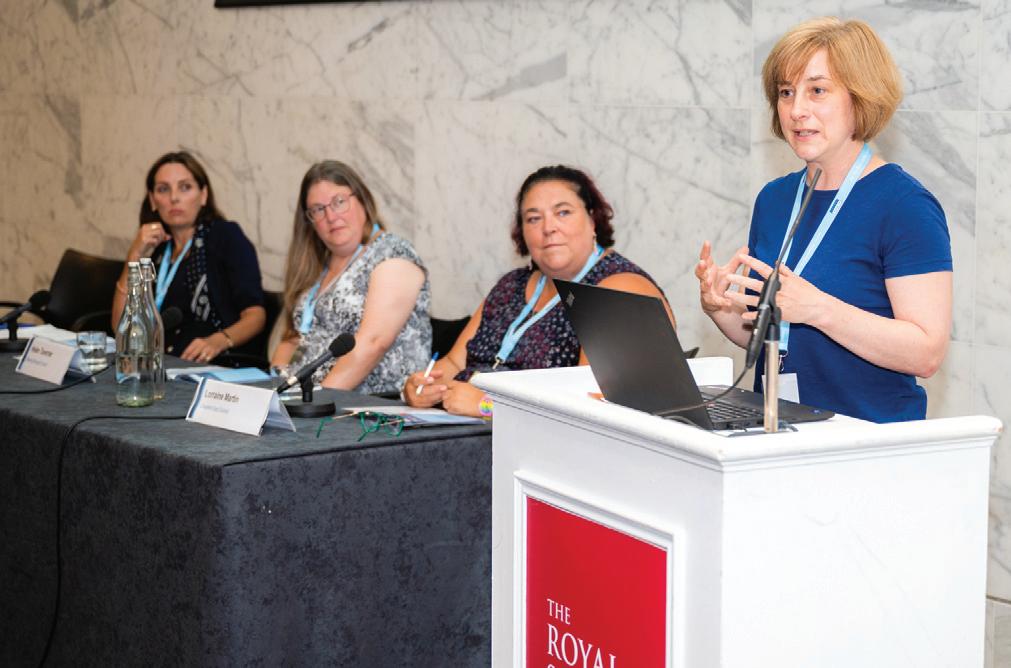
The day’s theme was Parking: A never ending topic, and featured presentations on:
• Clean air: Cathryn Brown, Bath and North East Somerset Council

• The Traffic Penalty Tribunal’s vision: Caroline Hamilton, TPT
• Delivering effective parking
services: Lorraine Martin, Cheshire East Council
• Moving traffic enforcement, Helen Taverner, Reading Borough Council.
Rukshar Ashgar, Alpha Parking’s operations manager, said: “We were delighted that 28 local authorities joined us for our seminar. We received encouraging feedback that the topics covered were relevant and informative, enabling likeminded professionals to network.”
The user groups will share examples of authority best practice and provide useful guidance, such as on the production of a parking and traffic management annual report and the online submission of penalty charge notice (PCN) numbers.
Events will take place in a number of locations across England and Wales in November.
Tickets are free, but are limited to four per local authority. Venues for the events will be confirmed soon.
The user groups replace the

previous cycle of regional PATROL workshops.
The PATROL (Parking and Traffic Regulations Outside London) Joint Committee represents over 300 local authorities in England (outside London) and Wales. PATROL provides information in relation to penalties issued from other road user charging schemes.
• Liverpool: 8 November
• Leeds: 15 November
• Birmingham: 16 November
• Cardiff: 22 November
• London: 23 November
• Exeter: 30 November.








A new car parking strategy for St Albans seeks to make its services environmentally-friendly and improve accessibility.
St Albans is a cathedral city in Hertfordshire. The strategy will provide a plan for managing public car parks owned by St Albans City and District Council and on-street parking over the next five years.

The parking plan sets out a number of key goals including tackling the climate emergency and improving accessibility. To achieve these goals ideas have been put forward including measures to reduce carbon emissions
and encourage eco-friendly transport options.
Projects put forward in the strategy for tackling climate change include introducing electric vehicle charging points at car parks and promoting car clubs. For example, Enterprise Car Club has introduced two vehicles to St Albans on a trial basis. These are available for registered users to borrow on an hourly or daily basis.
Proposals to improve enforcement when motorists park inconsiderately or illegally include targeting congestion caused by parking outside schools and identifying hotspot areas for illegal parking.
To better meet the needs of disabled and older people, the council is also looking to review current parking place
Strike action that has been affecting parking services in south London has ended after a pay deal was agreed.

Wandsworth Council civil enforcement officers (CEOs), who are employed private contractor NSL Parking Services, had been set to walk out for four days in September but the dispute ended after the GMB union accepted a pay rise of 11.5%.
The dispute between the GMB and NSL started in June and resulted in 20 days of strike action. The union was seeking a pay deal that reflects the high rate of inflation and cost-ofliving crisis.
The deal means the CEOs basic wages will immediately increase by 11.5% and they will also receive
guaranteed pay rises for the next two years.
Paul Grafton, regional officer at GMB, said: “It’s about time this dispute got settled, as our members have had to take a lot of strike action, foregoing their wages on each occasion. This offer shows that the money was there all along, and if NSL had been honest about what they could afford from the outset, we wouldn’t have seen so much disruption on the streets of Wandsworth.”
An NSL spokesperson said: “We are pleased an agreement has been reached with the GMB which will protect our colleagues against ongoing economic uncertainty.”
designations.
The strategy also seeks to make the best use of digital technology and ensure more efficient enforcement of parking. Digital technology could result in the introduction of paper-free virtual parking permits and the scrapping of pay & display machines.
The council’s public realm committee discussed the draft strategy at its meeting on 15 September and agreed a consultation can take place. Residents, businesses, community groups and other organisations in the city are being urged to give their views to help shape the final document.
Cllr Helen Campbell, the committee’s chair, said after the meeting: “We are working to develop a parking strategy that achieves a number of clear objectives.
We want it to meet the needs of all our residents including those with mobility issues. We also want it to support the local economy, provide visitors with a positive experience and tackle the climate emergency.
“The strategy will provide us with a framework for the next five years, shaping the projects we will undertake to further improve this important public service. We want to hear from as many residents, businesses and community groups as possible to find out what their priorities are and to ensure that the strategy is responding to their needs. All the feedback we receive about the key principles and the projects that we are proposing will be considered before we complete the final strategy document.”
Devon County Council has revealed plans to increase the price of parking permits for the first time in seven years.
Residential permits in Devon have not increased since 2015 and a property’s first vehicle permit will rise from £30 to £35 irrespective of carbon emissions.
Any second permit will then be more expensive depending on the vehicles’ carbon emissions. Permits for second vehicles will cost:
• £45 for electric and lowemitting vehicles in Band A (less than 100g/km)
• £55 for Bands B – K (101225g/km)
• £65 for the worst emitting vehicles in Bands L – M (226+ g/km).
The county council said the Consumer Price Index has increased by approximately 19.5% since the last rise –more than the planned base permit increase of approximately 17%.
The price for a business permit for one vehicle is set to increase to £35. Permits will also be required for motorcycles (first permit £35, second permit £45, extra permits £65).
The permits will be virtual to reduce waste.
Richard is also Chairman of the Yorkshire and Humberside region at the BPA, and is part of the Technology, Innovation and Research Board and Public Affairs Board for the trade association.
As the first supplier to replace traditional magnetic stripe cards with barcode technology, WPS Parking Solutions has often been at the forefront of key changes in the parking industry. WPS UK continues to strengthen its position in the market with the appointment of Richard Boultbee as Managing Director, who is looking to continue to drive the business forward.
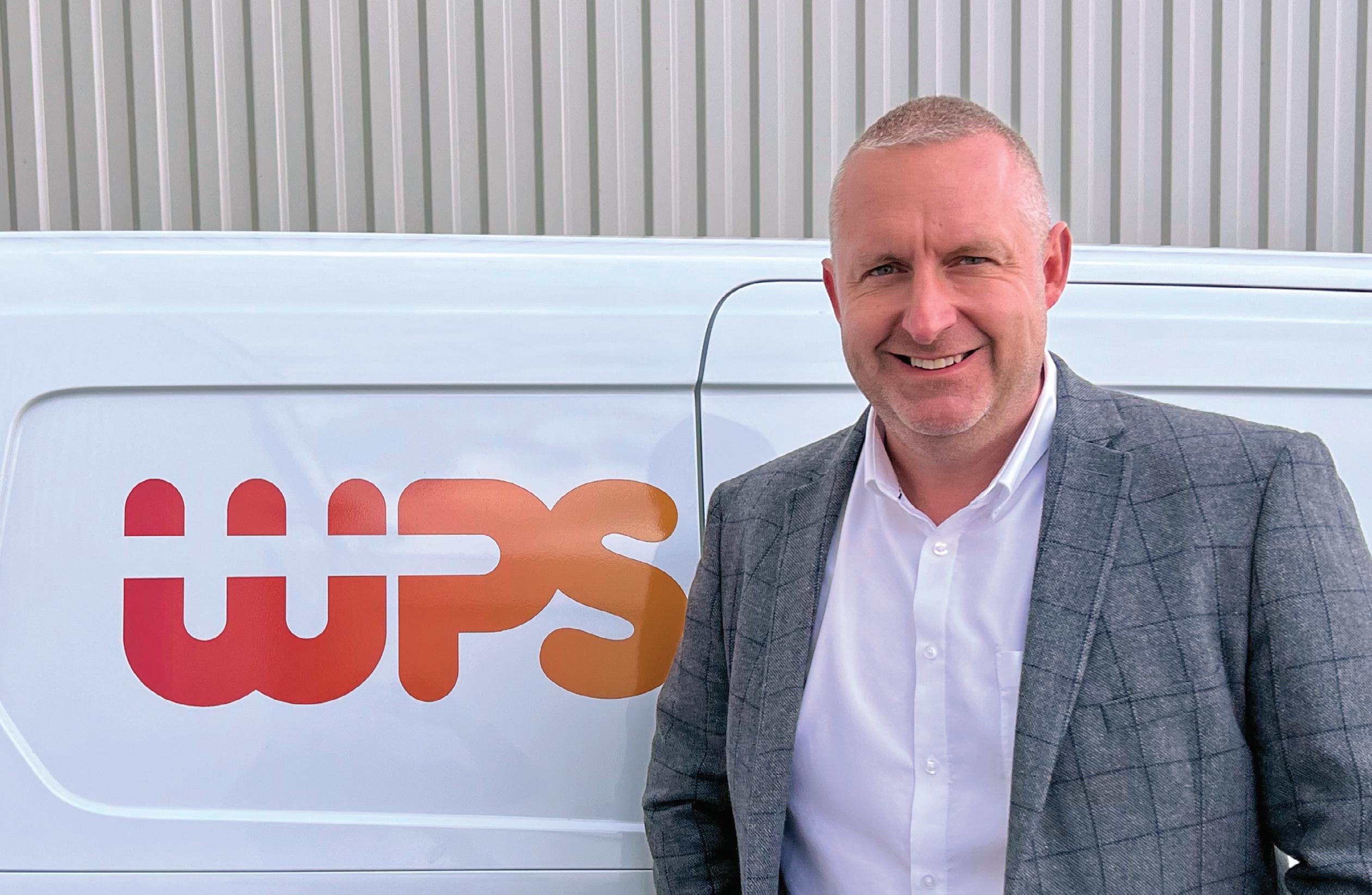
WPS Parking Solutions are specialists in innovative cloud-based automated parking solutions. Since its inception in 1985, WPS has grown into an international organisation employing more than 350 professionals. The company operates in the Netherlands, Belgium, United States, Canada, Brazil and in the United Kingdom.
With the appointment of Richard Boultbee as Managing Director of WPS UK, a fresh approach is sweeping through Swindon, where the UK business is headquartered. With over 20 years’ experience under his belt, Richard is no stranger to the parking industry. Having held executive management positions within several parking-related companies – as both supplier and customer, in both public and private realms – Richard has extensive experience in parking management technologies.
Throughout his career, he has been customer focussed and a driver of modernisation and change. In 2017, Richard started a tech company from scratch in the parking industry and turned it into an awarding-winning, high-growth enterprise.
At WPS, Richard will play a pivotal role in continuing to grow the WPS brand and range of technology solutions within the UK. Richard says he is delighted to be joining WPS UK at this exciting time: “We continue to thrive after the throes of a pandemic and I plan to demonstrate we are more customer focussed than ever, with our new open and adaptive approach to parking. We are proud to be the first parking solutions provider to embrace the wider parking industry and to be leading on the integration with the National Parking Platform (NPP). We already have live integrations with JustPark and ZatPark, and this list will continue to grow rapidly.”
Back in March, WPS introduced an exciting new platform that brings together complimentary solutions to its central offering using both its own, third-party applications and operator services to deliver a seamless parking solution.
Richard explains: “It is vital to emphasise modern parking is no longer just about the destination. Parking is a customer-led journey and WPS seeks to make that journey as smooth as possible. We want to provide parking operators with the technology to provide their customers with the experience they choose. If their choice is to pay for parking via their favourite app, our solutions will facilitate that journey in real-time and in a frictionless manner. Our ultimate goal: enabling the perfect motorist experience through providing

RichardBoultbee
heralds a new beginning for WPS UK
Modern parking is no longer just about the destination – it is a customer-led journey
Richard Boultbee
parking solutions that not only facilitate, but also enrich every type of customer journey.’’
The WPS Parking Platform connects today’s parking customers to the mobility services and solutions of tomorrow. At the core of this Platform is the parking management system – ParkID. This cloud-based solution is easy to use, with KPI data focussed on our customers’ needs. Richard explains: ‘’By operating in a cloud-environment and using the latest web technologies, we ensure our products and services are updated regularly. This is how modern technology is managed globally and this practice saves our customers time, adds convenience and reduces costs.”
The Parking Platform is supplemented by the WPS Marketplace; offering new and innovative applications from an evergrowing number of partners that can be deployed quickly and easily.
The WPS Platform is also hardware interoperable. The ParkID parking management system either runs on our ParkAdvance equipment or on complimentary third-party equipment, using ParkID Connect. Richard adds: “Our first third party hardware supplier has recently been added to the WPS Marketplace: Prestop, an international manufacturer of premium kiosks.’’
“Our permit ticket system, for instance, is very flexible and primarily businesses in the health sector attach great value to this. Employees, regular visitors or patients that receive ongoing treatment must have access to simple and appropriate parking rates and permits, and the parameters that we can add to that are unlimited. Also allowing people to pay for those permits at the machines, rather than via a deduction from their salary, is a useful flexibility that comes as standard in our solution, so there are no hidden costs.
Prestop
One look at the WPS Marketplace shows the company has integrations with a plethora of suppliers in the areas of hospitality, loyalty, payments, permits, reporting, reservations and wayfinding. Richard elaborates: “The WPS Platform is evolving into an enabler for mobility, supporting an ever-growing number of varied customer journeys. We are very proud to have integrations with JustPark, and ZatPark, and with RingGo just about to go live. We are keen that all leading providers of parking payment technology and parking enforcement management software can deliver services through our technology. Furthermore, we offer our own parking payment functionality through the WPS Pay App.
The National Parking Platform (NPP) is a publicly-owned, national facility funded by the Department for Transport that enables Parking Operators (public and private) to communicate digitally via APDS protocols with Service Providers. “Our NPP membership means our customers (the operator) are able to provide their endusers choice and freedom on how to pay for parking. Whether that is localised using WPS equipment on site, or through other apps. The NPP is currently in its pilot phase with Manchester City Council, but many other Local Authorities are registering interest or have chosen to be part of the next phase. As a technology provider, if you are on the Platform – most of the key players are – it means end-users will be able to choose how to pay for their parking through the app of their choice.
“It again, goes to show, when customers opt for a solution from WPS, they can be confident they have chosen a parking solutions provider who is front and centre of market developments, is flexible, and forms partnerships with pioneers in the industry. We have already established sound partnerships and are continuously on the look-out to work together with mobility and operator software and hardware solutions providers that can add value to the customer journey.”
“Our solutions are designed to bring maximum benefits to owners/operators and customers alike, centred around operational efficiency, integration capabilities, and the perfect user experience.


“We provide ticketed parking, ticket-less and barrier-less parking, as well as loyalty schemes and validations.
“Our ParkAdvance terminals have clean and easy-to-use interfaces, that are both robust and reliable and, uniquely in the market, include a sleek 24-inch touchscreen. This allows tremendous opportunity for customisation in terms of colours and customer branding.”

ParkAdvance PoF terminal

When asked what Richard is most looking forward to tackling, the answer is simple: “I am looking forward to cementing WPS as a leading parking technology company in the UK. I want us to be customer focussed in both product and after sales service. We are going to continue to modernise our approach. We have already got the technology to be able to provide customers a great solution, we just need to realise its potential. Having been a customer, customer service is incredibly important to me. We have recently invested in a new modernised customer service system that will allow our clients to see the increased levels of service.
“We believe our strength not only lies in our products, but also in the after-sales service. To be able to offer our customers faster response times because we’ve got efficient systems that can help us do that will be a game changer. What I found successful in the past is to ensure we combine both product, after-sales service and sensible pricing into one complete experience. Now that I have joined WPS UK, I will see to it that we will take it to that next level.
“I am very fortunate to work with a team of passionate people who fully support these ambitions. We have team members who have seen WPS grow from its infancy to what it is now, and really want to continue to make WPS a success. I am keen to provide them with all the tools necessary for further success, because they deserve it. Our field service engineers often go above and beyond the call of duty to provide the best service, and that’s great to witness. Together we start our journey into a new era in parking, an era where I have no doubt the company is bound to prosper.”
Software provider Unity5 is stepping up its growth plans following an investment from technology sector investor Synova.
Synova specialises in the technology sector, making investments and providing operational expertise to help its partners to outperform their targets.
Synova is investing in Unity5 alongside the company’s co-founders Dave Herbert and Lukasz Kieruczenko who will continue to hold a material stake in the company.
The investment is being made via Synova V, an £875m investment fund that partners with exceptional growth companies within the technology, business services, financial services, and health and education sectors. Synova has no prior investments in the parking sector, allowing Unity5 to retain its independent position.
Unity5 delivers software as a service (SaaS) solutions through its ZatPark, ZatPermit and ZatEnviro software. The company provides a complete turnkey solution for both public bodies and private companies which need to monitor and manage parking, traffic and mobility services, as well as environmental regulations.
Unity5 says that demand for software propositions in its market has increased in recent years due to the increasing automation and digitisation of the sector, as well as an enhanced regulatory regime for operators which is driving increased complexity.
In addition to focussing on organic growth, Synova’s investment in Unity5 will provide capital for targeted technology mergers and acquisitions (M&A) activity to expand the company’s product set and reach, as well as support international expansion after recent wins in Europe and the Asia-Pacific (APAC) region.
Alex Bowden, partner at Synova, said: “We are very excited to be partnering with Dave and Lukasz to facilitate Unity5’s growth plans. It is a business that has performed
strongly over the last few years driven by the increasing complexity of its underlying markets. That, alongside the strength of its SaaS proposition, allows Unity5 to consistently deliver exceptional quality and service to its expanding client base. We look forward to supporting Dave, Lukasz and the wider team at Unity5 as it continues to accelerate its growth over the coming years.” Day to day management of Unity5 will continue with the same director team: Dave Herbert, Lukasz Kieruczenko, Celina Herbert and Dan Jefferson.
Alex Bowden and Matt Charman from Synova have joined the Unity5 board of directors and will work closely with the rest of the director team on both short term objectives as well as the strategic direction of the company.
Unity is looking to appoint a non-executive chairman.
Dave Herbert, Unity5 chief executive, said: “Until now Unity5 has been financed through shareholder investment and the reinvestment of retained revenues. This pragmatic management has fostered the company’s ethos of building close relationships with clients, and relatively recently allowed the company to continue its growth


during the uncharted times of the pandemic.
“Building our business at scale was always an ambition and organic growth wasn’t going to get us where we wanted to be, but it’s taken a while for us to identify the partners with whom we’d most likely succeed.
“We had many conversations with potential partners having appointed professional advisors to help us with the process. Synova ended up feeling like the right fit for us, particularly in terms of complementary experience, shared values and their position as the most successful technology investor in Europe.
“We’re looking forward to the next step on our growth journey with Synova and their team. Their support will allow us to invest more into our technology platform, while at the same time providing invaluable assistance in developing new features, as well as larger customer support and development teams to build on the fantastic progress that we have made since Lukasz and I founded the company more than 12 years ago. Expansion is part of our future plans. However, continuing to develop our products and services to support the Private and Public Sector operators in the UK is our number one priority.”
Richard
Boultbee joins WPS from Creative Car Park, where he was director of business development. Prior to this, he was executive director of International Parking Systems (UK), having launched the company in 2017.

He previously held a number of senior roles at Metric Group, where he worked for over 13
years following a decade working at Amber Valley Borough Council in Derbyshire as its parking manager.
Boultbee is also chairman of the Yorkshire and Humberside region at the British Parking Association, and is part of its Technology, Innovation and Research Board and Public Affairs Board.
On joining WPS he said: “What I found successful in the past is to ensure to combine both product, after-sales service and sensible pricing into one
complete experience. Now that I have joined WPS UK, I will see to it that we will take it to that next level.
“I am very fortunate to work with a team of passionate people who fully support these ambitions. We have team members who have seen WPS grow from its infancy to what it is now, and really want to continue to make WPS a success.”
Boultbee takes over from Simon Jarvis, who has moved into the consultancy sector.
Boultbee has been appointed as the new managing director of parking systems specialist WPS Parking Solutions.Nigel Williams has been elected as the new president of the European Parking Association (EPA), which acts as the umbrella organisation for European parking associations.
Williams has worked in the French and UK parking sectors for over 30 years. He was respectively managing director of Vinci Park UK (now Saba UK) and development director for Q Park UK. In 2008 he started the UKbased parking consultancy Parking Matters and its French sister company Statiom in 2013.

Williams has served as chair of the British Parking Association board for eight years and has long been active in the EPA.
Williams takes over from Laurence Bannerman, an Italian parking specialist who has led the EPA for the past seven years.
During his period in office, the EPA’s membership expanded
to 22 national associations. Bannerman also led the EPA’s involvement in a number of cross-sector and international initiatives. The EPA has worked closely with POLIS, a network European local and regional authorities working together to promote sustainable mobility through the deployment of inno-
vative transport solutions.
The EPA is also working with the USA’s International Parking & Mobility Institute (IPMI) and the British Parking Association to develop is the Alliance for Parking Data Standards (APDS). This not-for-profit organisation has a mission to develop, promote, manage, and maintain a

uniform global standard that will allow organisations to share parking data across platforms worldwide.
The EPA has also developed relationships with a number of European universities and plans to draw on their research when seeking to influence policy decisions on parking and mobility matters.
Passing on the mantle Bannerman said: “All the very best Nigel, I’m sure you will turn all the challenges into important and successful opportunities for all the sector.”
A new board was unveiled during the 20th EPA Congress, which took place in Brussels, Belgium, last month.
During the congress it was agreed that the EPA would move its headquarters from Germany to Brussels. The relocation of HQ reflects the parking association’s desire to be at the heart of decision-making in the European Union and have a voice among European Commission members.
We currently supply and have vacancies around the UK for Permanent and Temporary positions:
• Civil Enforcement Officers
• Environmental Enforcement Officers
• Parking Back Office (Appeals/Notice Processing/Correspondence)
• Parking Change Management
• Interim Parking Managers
• Car Park Attendants/Marshalls/Stewarding
• Parking Supervisors (Both Enforcement and Back Office)
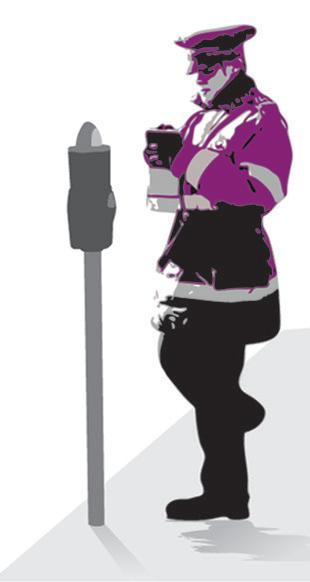
• Parking Management (Both Enforcement and Back Office)
• Heads of Parking/Directors
APCOA Parking enforcement and notice processing staff who work for Sandwell Metropolitan Borough Council have been recognised for helping to deliver an event during the Commonwealth Games.

APCOA assisted the council’s highway service to ensure roads used for the Queen’s Baton Relay remained safe as the event visited all six towns across the borough.
The team were presented with gift vouchers at a special ceremony.
Anjna Patel MBE, Sandwell’s principal manager of the parking section, said about the APCOA team:
“They were extremely professional and worked very hard rising to all the challenges that were thrown their way. They worked long hours and demonstrated great dedication and commitment. Together we are a fantastic team!”
APCOA’s regional managing director Kim Challis responded: “It’s always lovely to hear positive feedback from clients as I know how hard all my APCOA colleagues work. We really appreciate the recognition by Sandwell Council and I’m so proud of everyone who was involved in this event.”
• Parking Technologies (Business Development and Project Managers/ Field Service Engineers/General Managers)
• Off Street Parking (Business Development, Contract Managers and Regional Managers)
• CCTV Operators – SIA and BTEC qualified
Looking for staff or need employment? Please contact our experienced team on:


Tel: 0203 668 5680
Email: parking@unity-recruitment.co.uk Web: www.unity-recruitment.co.uk





Local authorities are implementing and planning the use of ANPR cameras to enforce a range of moving traffic offences.
The UK government has given English councils outside London the new powers under Part 6 of the Traffic Management Act 2004 via a package of three statutory instruments (SIs). Councils can now issue fines to those driving into a bus lane, stopping in a yellow box junction, making banned right or left turns, illegal U-turns and driving the wrong way in a one-way street.
The Moving Traffic Enforcement Seminar will attract delegates from local and national government, highways agencies, police forces and motoring organisations. The seminar is an opportunity for attendees to hear the latest research and share best practice.




EVolution is an independent source of news and analysis for organisations planning, creating and operating electric vehicle and zero-emission charging infrastructure.
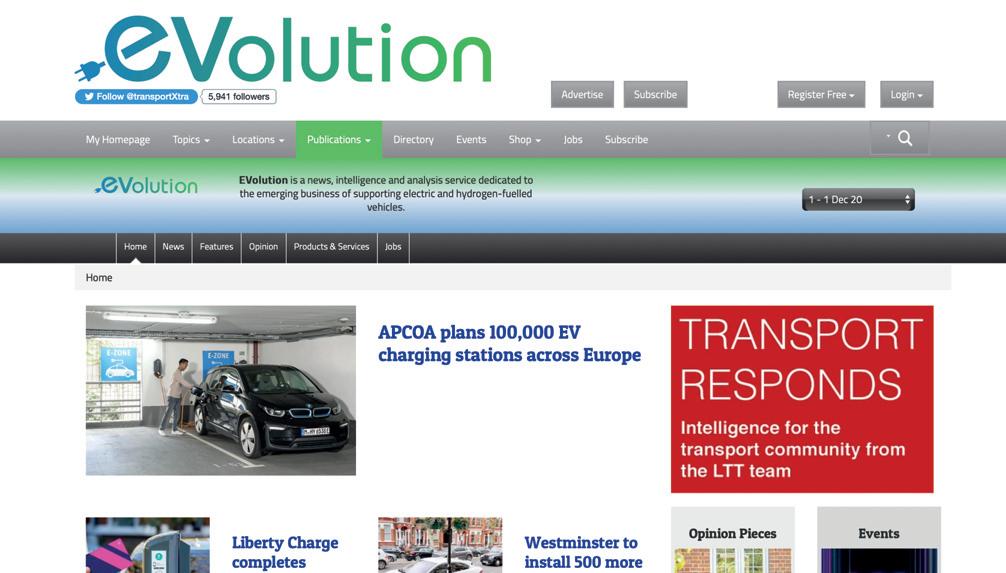
Existing magazines, websites and events covering EVs focus on the vehicles themselves. What makes EVolution different is that is the first content space dedicated to the emerging business of developing the infrastructure required to support electric vehicles.
EVolution makes the business of providing electric vehicle infrastructure its core mission.
In parallel to the website and print version there are:
Digital editions
Webinars
Conferences and exhibitions
The EVolution Awards.
EVolution is produced by the highly regarded Landor LINKS editorial team, along with expert contributors, that bring knowledge and expertise grounded in the worlds of transport, parking, traffic management and urban development.
Send your story ideas to: mark.moran@landor.co.uk
EVolution covers themes such as:

The planning and operation of EV charging
Designing EV infrastructure for car parks, motorway service areas, workplaces and the home


Decarbonisation policy
The development of EV charging networks
Chargepoint technology
The creation of EV hubs
Kerbside charging provision
The enforcement of EV charging bays

Connecting EV infrastructure with payment services

The uptake of EVs by drivers, commercial fleets and car-sharing providers
Vehicle design and powertrain R&D




The distribution of zero and low-emission fuels
Vehicle-to-grid (V2G) technology


Sourcing green energy for EV charging
Legal and regulatory developments


The role of EVs within clean air schemes
Managing fire safety in EV charging areas
Developments in the energy sector
To help us tell promote your organisation via print and online advertising, or a presence at Landor LINKS events contact Jason Conboy on jason@landor.co.uk











Editorial
Managing editor:
Mark Moran
Tel: 020 7091 7871
mark.moran@landor.co.uk
Production and design production@landor.co.uk
Advertising, sponsorship, marketing and exhibition packages
Jason Conboy Tel: 020 7091 7895 jason@landor.co.uk




Subscriptions
Christina Pierre
Tel: 020 7091 7959 subs@landor.co.uk
Accounts
Irina Cocks
Tel: 020 7091 7854
irina.cocks@landor.co.uk
Business manager
Rod Fletcher Tel: 0191 280 1410
Printed by: Pensord
Tram Road, Pontllanfraith, Blackwood NP12 2YA
Published by: Landor LINKS Ltd, Apollo House, 359 Kennington Lane, London SE11 5QY
© Landor LINKS Ltd 2022
www.landor.co.uk
Registered members of:

The Independent Press Standards Organisation www.ipso.co.uk
The Professional Publishers Association www.ppa.co.uk
The transition to zero-emission travel will be good for the environment, so it seems appropriate that the infrastructure enabling the use of electric vehicles draws on nature.
Autonomous electric vehicles traverse a vivid green landscape. This month’s cover showcases a striking vision of the future of travel created by young artist Lauren Murray, who has won a competition organised by Coventry University’s Centre for Advanced Low Carbon Propulsion Systems (C-ALPS) and the BA (Hons) Illustration courses. Her striking design will now become a mural that will inspire those working at C-ALPS.
Murray turned to nature when envisaging how we might travel in the future. The electric autonomous vehicles she created can take to the air with wings inspired by beetles. A snakelike train travels through a landscape in which real trees are complemented by solar panel arrays inspired by flowers that feed into energy storage towers that resemble beehives.

The landscape that the mural imagines could soon become a reality if flowing, sinuous designs for charging hubs unveiled by companies such as Be.EV, Vital EV and SolarBotanic are realised. It is reassuring to see there is desire to move away from straight lines when designing EV infrastructure, echoing the energy that is put into the design of the vehicles being serviced.
 Mark Moran Editor
Mark Moran Editor

Zero-emission infrastructure should be designed with as much care as the vehicles it serves
12,000 car parks
APCOA Parking has revealed a plan to deploy up to 100,000 new electric vehicle charging stations in parking facilities across Europe by 2035.
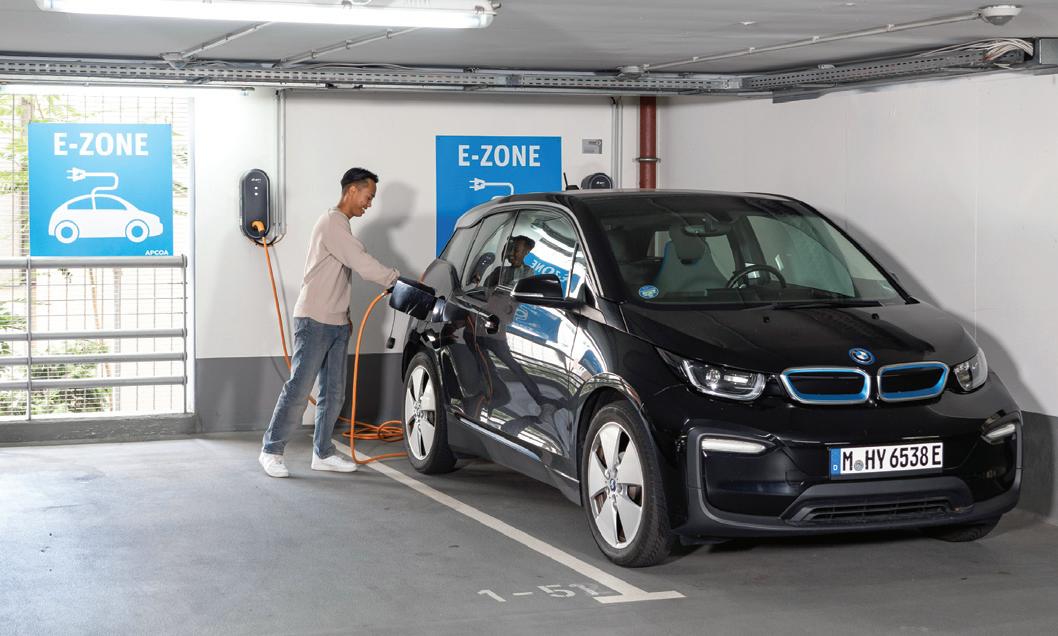
As part of its EV strategy, APCOA will make the investment to expand its AC charging infrastructure to become a EV charging operator.
In parallel, the company will work with strategic partners from the automotive industry as well as energy and charging infrastructure providers to deploy an additional 1,000 fast-charging stations across its location network.
APCOA says it has 1.8 million parking spaces at over 12,000 locations in 13 countries, including the UK and Germany, where the group is headquartered.
To date, around 2,500 EV charging stations are available in car parks operated by APCOA
Airport Parking Hotels (APH) has launched a new park & ride with EV charging service at its car parks serving Gatwick Airport and Manchester Airport.
From September, APH customers driving electric vehicles can book the new off-airport parking with EV charging package at both offairport sites, with the flexibility of pre-booking or upgrading on the day.
EV charging costs are £39.99 for a 30kWh charge and £59.99 for 60kWh on top of the normal parking charges.
The service offers EV owners a guaranteed parking space and a trained driver who will move the car to a secure parking bay for the duration of the trip once charged.
Drivers are asked to bring their own charging cable and arrive with a minimum charge of 5% remaining on arrival.
APH managing director Nick Caunter said: “With so many drivers now switching to electric vehicles, we needed to provide these APH customers with another valuable service when flying abroad.”
A new digital platform developed by APCOA will support the charging infrastructure. It will use nonproprietary hardware and be operated independent of chargepoint ownership.
APCOA says this open and compatible set-up will allow the integration of multiple partners and services and represents a unique proposition in the market.
The APCOA Flow and APCOA Connect apps will serve as the front-end to the
parking customer. The operator says it will be able to manage the entire EV charging process as well as additional value-added service including locating, booking and payment.
Philippe Op de Beeck, chief executive of APCOA Parking Group, said: “The transition to electric mobility as the dominant technical solution in road traffic is an irreversible trend. EV charging infrastructure thus represents a major component of the
transformation of APCOA’s car parks into ‘Urban Hubs’. For customers, the extended service infrastructure will increase the attractiveness of our locations.
“For us as an operator, we see substantial revenue potential from upgrading our parking sites with EV charging and other urban services. In keeping with its commitment to carbon neutral solutions, APCOA’s charging infrastructure will run primarily on green energy.”
APCOA cites a decision by the European Parliament to ban sales of new cars with combustion engines from 2035 as being a highly significant development.
A recent study from the market analysts at Dynata confirms that consumers are increasingly willing to choose an electric vehicle, even in countries that have so far been somewhat reluctant to make the transition: 64% of Germans expressed an interest in buying an electric or hybrid vehicle.
Westminster City Council has appointed Siemens to install a network of an additional 500 Ubitricity electric vehicle (EV) chargepoints in the borough by the end of March 2023.

The additional chargepoints are set to grow to the council’s existing network of over 1,500 chargepoints to more than 2,000.
The chargepoints, which are directly installed on existing street lampposts, charge at a speed of up to 5kW and take just under two hours to install.
The roll-out is planned to be installed into key residential and commercial locations, allowing residents to charge hybrid and electric vehicles on the street where they live.
The council says its goal is to make EV charging more accessible, with a particular focus on the residents in Westminster who do not have access to private off-street
parking and charging.
Lack of accessible public EV charging points is a common barrier to EV adoption, which is why Westminster council is also reaching out to the community and asking residents to request an EV chargepoint near to them using an online form.
Siemens has now completed
more than 4,500 Ubitricity chargepoint installations covering the breadth of the city, significantly funded from the Go Ultra Low Cities Scheme, and leading the way to improve London’s air quality. The roll-out began in late September 2022 and is set to be completed by the end of March 2023.
Which? is calling for urgent improvements to the UK’s charging infrastructure to allow drivers to switch to electric vehicles (EVs) with confidence, as new research reveals significant flaws with the networks have resulted in threequarters (74%) of EV owners reporting that they are dissatisfied with the current infrastructure.
The consumer champion believes the UK government needs to move quickly to address issues with the UK’s charging infrastructure, including poor reliability and confusing payment options, as well as doing more to ensure chargepoints are available where drivers need them, in order for more people to make the switch to electric vehicles.
The survey of almost 1,500 Which? members who own an EV or plug-in hybrid vehicle (PHEV) highlights current difficulties with finding a charger that works. Half (48%) of EV drivers who use the public charging infrastructure find it a challenge simply to find a charging point in good working condition. Meanwhile, four in ten (40%) reported that they have experienced a non-working charger and four in ten (43%) have faced ‘technical issues’ with charging points.
The Which? research also exposed difficulties around payment at public chargepoints – with six in ten (61%) having experienced an issue making payments.
Respondents also reported that there are not enough options when paying for
electric charging. One in six EV drivers (18%) who no longer use public chargers were put off by the lack of convenient payment options, while eight in ten (84%) who currently use public chargers want to be able to pay via contactless bank card to avoid the hassle of paying via multiple apps. Currently, only a limited number of chargepoints offer payment by bank card.
The survey also revealed that around half of those using the public charging networks believe they do not have adequate access to chargepoints close to their homes (48%) and nearly half (45%) felt this was the case while on journeys. Which? asked EV drivers to estimate how far the nearest public on-street charging point was from their homes and nearly half (45%) estimated that the nearest was more than a 20-minute walk away. This is an issue for drivers that do not have off street parking and are unable to charge at home, but are faced with a long walk to and from their car while charging takes place.
Meanwhile, one in five (20%) EV
owners who no longer use the public charging infrastructure were put off by a lack of adequate chargepoints, while one in five (21%) drivers who have never used the public networks have been put off for the same reason.
Sue Davies, Which? head of consumer protection policy, said: “Our research shows that the public EV charging infrastructure is falling short as many drivers struggle to find reliable charging points in good working order, have to navigate confusing payment systems, or are unable to rely on adequate charging points close to their homes or have to get to them through a long journey. The government must move quickly to implement its plans to improve the consumer experience of using the public charging networks by extending reliability standards across the full network and ensuring proposals for payment roaming to make paying to charge much simpler. Charging must be easy, reliable and seamless to support people making the move to an electric car.”
Over 20 chargepoint operators have signed an open letter sent to HM Treasury and new Chancellor of the Exchequer Kwasi Kwarteng calling for an immediate cut in VAT on public charging. The FairCharge campaign coordinated the letter, which has been endorsed by 23 chargepoint operators (CPOs) asking for a reduction in VAT from 20% to 5% in line with private charging.
Signatories include the CEOs of Fastned, InstaVolt and Osprey Charging who all want immediate action. The letter states: “One quick solution, that is totally within your control, is to heed the FairCharge campaign’s call for an immediate cut in VAT on the electricity delivered by our networks. Such a cut would immediately feed through to a
reduction in prices. Further, it would show the strength of the government’s continued commitment to transport decarbonisation.
“Fundamentally, it would remove the current VAT anomaly that results in those living in terraced houses or flats who need to use our networks who pay 20% VAT as opposed to those with the ability to charge at home who pay 5% VAT.”
Signatories of the letter are:
• Karl Anders (MER Charging)
• Andreas Atkins (Ionity)
• Keith Brown (Paythru)
• John Byrne (ESB Energy)
• Ed Chadwick Till (Motor Fuel Group)
• Will David (Clenergy),
• Adrian Fielden-Gray (Be.EV)
• Bruce Galiford (RAW Charging)
• Michael Gibson (Fuuse)
• Linda Grave (EV Driver)
• Daniel Heery (Charge My Street)
• Eugenio Herrero (SWARCO)
• Keith Hounsell (Plug-N-Go)
• Neil Isaacson (Liberty Charge)
• Ian Johnston (Osprey)
• Peter Lagesse (CityEV)
• Michiel Langezaal (Fastned)
• Adrian Keen (InstaVolt)
• Dr Chris Pateman-Jones (Connected Kerb)
• Melanie Shufflebotham (Zap-Map)
• William Silverstone (Dragon Charging)
• Richard Stobart (Char.gy)
• Lindsay Wallace (For:EV).
The FairCharge team met with the Treasury on 6 September as part of its campaign for a reduction in VAT from 20% to 5% on public EV chargers.
The campaigners, who include a motoring journalist, say they were “very frank” about what the “catastrophic” increases in charging costs will mean for the EV transition.
Following the meeting the campaign’s chair, motoring journalist Quentin Willson, wrote “FairCharge’s message is stark: If the government and the Treasury don’t address this VAT anomaly and cap electricity costs for public charging, then they will inadvertently risk sweeping away a decade of hard work, waste the billions already spent in support of EV adoption, halt investment in charging infrastructure and prevent the development of an industry that will create thousands of clean, highly skilled and highly paid jobs that will help move our society closer to cleaner urban air and energy independence.”

People in Nottingham are now able to ride in unique taxis that have been specially modified with the latest, highly efficient, wireless charging technology, to make them easier for drivers to recharge. The Wireless Charging of Electric Taxis (WiCET) trial is a governmentfunded project that has installed wireless charging equipment on to electric hackney carriages and into a taxi rank in Nottingham.
Five wireless ground transmitter pad systems have been installed at the main taxi rank near the train station, and nine electric hackney carriages have been retrofitted with wireless receiver pads –five LEVC TX Taxis, and four Nissan Dynamo taxis.
Electrification of taxi fleets in congested city areas is seen as a crucial step in the reduction of transport
emissions and improving air quality. However, the time taken for high-mileage taxi drivers to recharge can lower the driver’s earning potential. Cable charging with physical connections is usually inconvenient and impractical in a taxi rank.
The WiCET trial gives drivers the opportunity to wirelessly recharge their vehicles, in-rank, while waiting for their next passengers. The system allows

simultaneous charging of multiple vehicles so that drivers can use the rank for short, top-up charging bursts while they queue for fares without needing to leave their vehicle. Wireless charging will take place when the driver, using the guidance of a screen in the cab, completes a simple process that aligns the taxi over the pad so that it charges while stationary. As the taxis move forward in the rank, the driver will then realign with
Real-world home charging costs for EVs have risen 30%,while public charging is 19% more expensive. These are among the findings in a new report published by Mina. EV charging payment specialist Mina has launched a quarterly report which provides real-world data on how EVs are being used across the UK and how much they really cost.
The data gathered by Mina reveals how long vehicles are being charged for,how much each charge has cost, where vehicles are being charged and how much these EVs cost to run on a pence-per-mile basis.
The Mina EV Report – Summer 22, looking at June-August,reveals that over the quarter real-world home charging costs for EVs have risen 30%,and public charging by 19%, while drivers on average only spend 45 minutes charging in public.
The report also highlights penceper-mile costs,trends and behaviours gathered from among the country’s largest group of EV users –businesses running vans and company cars.Its findings are also compared to Mina’s historic data.
Mina chief executive AshleyTate said:“There’s a lot of discussion
about the real cost of charging EVs, but much of it is entirely theoretical, and based on lots of assumptions and‘what-ifs’.At Mina,our technology monitors every single charge,and every piece of associated data from the moment a car or van is plugged in,so we know exactly what is going on in the real world,the second it happens.
“We know every tariff,at home and in public,we can see how green that electricity is,the carbon impact in
real time of every kWh and how much it costs for every kWh.This is transformative,because from this you can build a picture of real-life costs, which is so important as the energy crisis unfolds,and also begin to understand behaviour and trends.
“As an example,I think many will be surprised at just how little time drivers who can charge at home actually spend charging in public. This will inform strategy in future,not just for businesses looking at costs
the next pad and charging will recommence. Drivers will be billed for their total charge at the end of the day through an app on their phone.
The trial was officially launched with a demonstration of the technology at the rank on Trent Street.
Richard Sander, WiCET project manager and technical specialist at Cenex, said: “Wireless charging has the potential for effective deployment across a wide range of applications from public transport to emergency vehicles and mobility solutions, and the results from our research will go on to inform future deployments.

“We are extremely proud to be starting the first physical trial of wireless charging of taxis in the UK here in Nottingham. This is a big step in understanding and demonstrating the potential of wireless charging as a core technology in the electric vehicle transition.”
and productivity,but for networks and authorities rolling out chargers and assessing demand.We believe this quarterly report will provide a benchmark for the entire EV sector, businesses and drivers.”
Key findings from the Mina EV Report: Summer 22

• Average pence per mile (ppm) cost for an electric van if charged at home is 10ppm – double that of the government’s Advisory Electricity Rate (AER) of 5ppm,while cars charged at home cost 7ppm on average.
• Nine out of ten charges result in car and van drivers being out of pocket if they reclaim costs using the AER.
•The average cost of home charging over Summer 22 was 26 pence per kilowatt hour (p per kWh) – more than 30% higher than the previous 12 months.
•The average cost of public charging is 56p per kWh – a rise of 19% over the previous year.
•There is a huge variation in public charging tariffs – from the cheapest of 30p per kWh to the most expensive 277p per kWh.
• On average,drivers only spend around three-quarters of an hour charging in public,generally taking on around 90-100 miles of charge.
A network of on-street electric vehicle chargers has gone live in Edinburgh. The network was funded by £2.3m awarded through Transport Scotland’s Switched on Towns and Cities Challenge Fund. In total, 81 new chargers (141 charging bays) were installed and went live this summer across the city, including 41 rapid and fast chargers (72 bays) at on-street locations with the remainder provided at Hermiston and Ingliston park & ride sites.
The roll-out is designed to encourage and support the take-up of cleaner, low emission transport like electric vehicles.
Cllr Scott Arthur, Edinburgh’s transport and environment convener, said: “We are expanding on-street electric vehicle chargers across the capital in a way that does not leave footpaths cluttered with cables and chargers. These new chargers will provide convenient charging for residents and visitors alike travelling around the city. Increasing the provision for greener technologies such as electric cars is a vital step in our wider plan for decarbonising transport in Edinburgh and for reaching our goal to become a net zero carbon city by 2030, which is brought into
sharp focus during Scotland’s Climate Week. Of course, choosing to walk, cycle or use public transport is the best travel decision people can make if they want to help us in our net zero ambition.”
Michael Matheson, the Scottish Government’s cabinet secretary for net zero, energy and transport said: “Phasing out the need for new petrol and diesel cars and vans by 2030, to help respond to the climate emergency, can only be achieved if drivers have the range confidence that comes from readily available charging
infrastructure. These latest chargepoints help provide that confidence to people who require EV charging in the capital.
“Our previous funding approaches have helped us deliver the most public electric vehicle charging points outside of London, and the most rapid chargepoints anywhere in the UK. We now want to see greater private sector investment and involvement in line with our draft vision for Scotland’s public EV charging network – delivering more infrastructure faster and in way that is more accessible than ever before.”
SSE Energy Solutions has opened its first ultra-rapid electric vehicle (EV) charging hub as part of an initiative to deliver 300 such hubs across the UK and Ireland within the next five years.


Located on Glasgow’s Castlebank Street, the six-bay EV charging hub is powered by traceable, renewable energy. The site will make it easier for EV drivers to charge their cars on the go, as well as providing a charging facility for local fleets and residents. The hub features ultra-rapid charging units of up to 150 kilowatts (kW) that can put drivers back on the road within 20 to 40 minutes.
SSE Energy Solutions estimates at least 60,000 charges could take place at the hub each year, which aims to accommodate domestic vehicles, fleet drivers and
taxis. SSE Energy Solutions aims to build a network of EV charging stations across the UK and Ireland as part of plans to meet increasing demands for EV infrastructure following commitments from governments and OEMs to end the production of petrol, diesel and hybrid engines.
Kevin Welstead, EV sector director at SSE Energy Solutions, said: “It’s vital that we face the EV infrastructure challenge head on if we’re to meet the ambitious decarbonisation targets agreed in Glasgow, less than a year ago, at COP26.”
More than 160 electric vehicle (EV) chargers are now available at dedicated hubs across Lanarkshire in Scotland. The charging hubs were built at locations which best suited the needs of the local community to help them make the switch to EV. A total of 167 chargers are now available across sites including train stations, libraries, community centres and country parks such as Strathclyde Country Park, Lanark Lifestyles and Getting Better Together Shotts.
Project PACE was part of the strategic collaboration with the Scottish Government to create over 44 EV charging hubs to help with the rising demand for low-carbon technologies and to facilitate local communities’ transition to cleaner and greener lifestyles.
Since its launch in 2019, the project, which was facilitated by Transport Scotland and local authorities in North and South Lanarkshire, has provided over 3,520MWh of energy which has enabled 13.7 million miles to be driven using green energy transport. This has helped save an estimated 2,380 tonnes of CO2 which would
have been emitted into the atmosphere had the same journeys been made by petrol or diesel cars.
The charging points have already been used over 105,000 times and enable an additional 4,150 EVs to be on the roads, increasing the number of electric vehicles in Lanarkshire by 400% compared to the baseline in December 2019.
As well as providing the local communities with the infrastructure to help them shift to electric vehicles, the project also has economic benefits for customers, with the PACE charging hubs forecasted to save between £1.4m and £2.9m on electricity grid connection costs.
Lynda Ward, Project PACE transformation director, said: “The results of PACE are there for all to see and I’m proud this project delivers such a significant contribution towards the electrification of transport. The usage of the chargers shows the appetite and value of projects such as PACE and enables people to make greener choices more easily. The project is a shining example of the power of collaboration to create a greener,
Scotland funds new chargepoint provision

Electric vehicles taking to the air with wings like beetles as they cross a landscape of solar panels that resemble flowers through which a train snakes. This is the striking vision of the future of travel created by young artist Lauren Murray, who has taken first prize in a mural design competition.
The competition to create the mural was organised by Coventry University’s Centre for Advanced Low Carbon Propulsion Systems (C-ALPS), and the BA (Hons) Illustration courses, with around 15 entries submitted for consideration. The mural will be installed later this year within the C-ALPS laboratory.
Murray, 21, who graduated this year from her course in Fine Art and Illustration, said: “This was the first time I’d done a professional commission; I’ve
been taught about the process throughout my course, but to actually do it was really interesting. I wanted to create something that was green and vibrant and my initial design was inspired by a garden, so the cars resembled beetles and one of the buildings looked like a bird bath.
“After doing some further research about the work of C-ALPS I refined my design, trying to show the process behind the creation of hydrogen fuel cells. An artist never sees their work as finished, but I’m pretty happy with how it turned out. My course at Coventry was great, my style has definitely developed and I really enjoyed the group working and the way we talked through ideas with one another.”
Tony Smith, laboratory manager at C-ALPS, said: “The standard of all the
entries was excellent and Lauren’s mural will make such a difference in the laboratory, it’ll really brighten up the space. Everyone here got to vote on which mural they wanted. I like the way blues and greens, which are colours associated with renewable technology and electric vehicles, have been incorporated into the design and also the way it looks to the future, with the nod to science fiction.
“The artists involved in the murals were happy to receive our feedback and take these comments on-board when putting together their final submissions. It’s been a great project. Not only will we get a fantastic mural, but the artists get the experience of working to a specific brief and with a client to put together something interesting.”
Two runner-up designs will also be created, one of which will also go in the laboratory, while the other one will be installed at a local school.
Smith added that some of the students involved in the mural project are planning to speak to local school children about the work being done by C-ALPS and the move towards low-carbon technologies.


Andy Spackman, course director for BA (Hons) Illustration, said: “Professionalism is a key part of the course right from the beginning, our students learn how to market themselves, how to work with clients and businesses and they all take part in an external project.
“All students have their own visual style and Lauren has a strong visual signature, her work feels unique which helped bring the subject to life. The way she approached this project has also been very professional, she was happy to take feedback from the client and adapt her work to their suggestions.”
Start
Q1: In general, would you support or oppose replacing fuel duty and car tax/VED with a pay-as-you-drive system?
Q2: Given what you’ve read and understood from this survey, do you think replacing the current system of vehicle taxation with a new pay-as-you-drive system which charges people based on the distance they travel is a good or bad idea?
Source: Campaign for Better Transport’s Pay-as-you-drive report
Half of people in Britain support replacing fuel duty and vehicle excise duty (VED) with a pay-as-you-drive scheme, according to a report from Campaign for Better Transport that explores the best ways to frame the case for reform and to implement a new system with fairness at its heart.
The report, Pay-as-you-drive: the British public’s views on vehicle taxation reform, examined over 3,000 UK adults’ views on road pricing. It found that three out of five people (60%) believe vehicle taxation needs reforming, with half (49%) supporting the idea of a pay-as-you-drive scheme compared to fewer than one in five (18%) opposing it. Support for reform grew among those surveyed by eight percentage points (from 41% to 49%) once they were presented with options for how such a scheme could be delivered, showing that some initial concerns around road pricing can be overcome.
Paul Tuohy, chief executive of Campaign for Better Transport,
said: “The need to reform vehicle taxation is becoming increasingly clear as we rightly move away from petrol and diesel vehicles in order to tackle climate change. What this research shows is that road pricing, far from being an unacceptable concept to the public, is in fact one that the majority of people believe can be implemented fairly and could in fact save most drivers money.”
Campaign for Better Transport’s report found that people thought a well-designed pay-as-you-drive system would be a fairer and more transparent way to tax motoring because it would include electric vehicle (EV) drivers and could ensure people who drive less, pay less.
Those polled thought that a scheme which included measures such as a tax-free mileage allowance would enable targeted tax cuts to specific groups, like those who have to drive for work, and would mean people who live in places
Is pay-as-you-drive a good idea?
where there are no public transport alternatives would not be unfairly penalised, either through a higher tax-free allowance or being charged a lower rate. A pay-as-you-drive scheme would have the added benefit of bringing an immediate tax cut to drivers with the removal of VAT on fuel duty.
The report also found that a number of measures would further increase public support for a pay-as-you-drive scheme including:
• a commitment to raise no more than fuel duty and vehicle excise duty do
• ensuring tax intake keeps pace with the increased take-up of zero-emission vehicles as the main reason for reform
• a government campaign to introduce the scheme which focusses on the ‘drive less – pay less’ benefits to help with the cost-of-living crisis
• a proportion of the revenue to be set aside for road maintenance and public transport improvements
• an arm’s length body to set and review emission standards and charging rates annually.

Pay-as-you-drive: the British public’s views on vehicle taxation reform, has been written by Campaign for Better Transport with funding from the European Climate Foundation (ECF), the Foundation for Integrated Travel, Transport and Environment and Uber. The report is based on the results of four focus groups and a detailed 60-question survey of over 3,000 adults from across the UK.
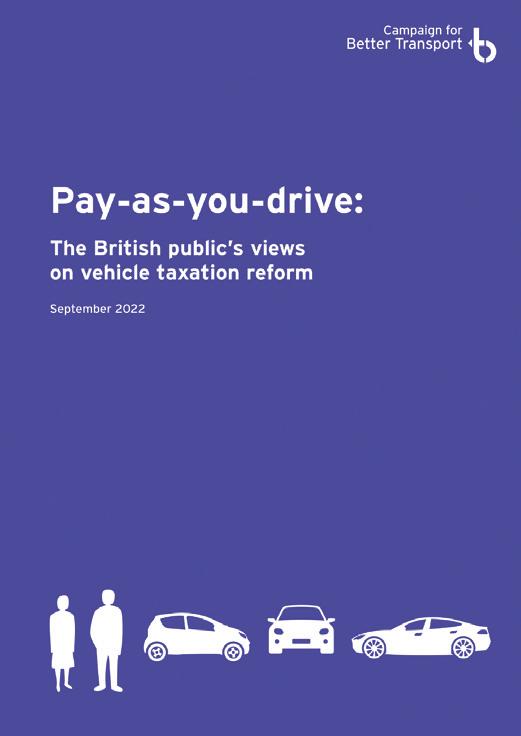
Campaign for Better Transport’s report concludes that a payas-you-drive system could progress in stages from a pilot for electric vehicles, to replacing fuel duty and vehicle excise duty with a fully ‘smart’ scheme with a varied pricing structure, which would replace any pre-existing local road charging schemes and provide the ability for people to opt out and pay a higher set annual charge instead.
The campaign is now calling on the government to establish a cross-party commission before the next general election to help secure agreement on the case for reform with a view to having a pay-as-you-drive scheme ready for implementation by 2025.
The report suggests that a national pay-as-you-drive scheme could progress through three options (although some could be skipped or combined):
• a simple per-mile charge for electric vehicles only. For nonelectric vehicles, fuel duty and VED could stay as they are
• a simple per-mile charge for all vehicles, replacing fuel duty and VED. The per-mile charge should be higher for more polluting vehicles
• a smart scheme, which varies the charge according to when and where the journey takes place, so that journeys for which there is no public transport alternative can be charged less.
Silviya Barrett, head of research at Campaign for Better Transport, who wrote the report, said: “Our research found that many of the common concerns around road pricing, things like protecting people’s privacy and not penalising people who need to drive, can be overcome with a well-designed pay-as-you-drive scheme. In fact, support for road pricing increased among the survey group over the course of the research once the scheme was fully explained, proving that public concerns about road pricing can be overcome.”
Since 1973,Campaign for BetterTransport has led calls for improvements to the country’s transport networks,campaigning for transport which is greener, more affordable and easier to use.Campaign for BetterTransport’s mission is to make sustainable transport available to all and encourage its use. bettertransport.org.uk
Many experts and policymakers agree distance-based road pricing,or pay-asyou-drive,would be required for vehicle taxation to keep pace with the move to net zero.While much has been written about how it could work,it has been a while since the public’s views on this have been tested.Based on focus group research and polling of over 3,000 people,this report represents the most indepth recent analysis of public views on road pricing.
The Campaign for BetterTransport found:
• a majority of respondents agree there is a need to reform the current system of vehicle taxation
• half support the idea of pay-as-you-drive,while only one in six oppose it
• support for the reform increases as people engage with the arguments and options for implementation,showing that initial concerns can be overcome
• people understand the need for electric vehicles (EVs) to start paying tax like other vehicles (though at a lower rate),as the money lost in fuel duty needs to come from somewhere
• the ability to budget better as vehicle tax becomes more transparent also appealed to participants.
Our new report, Pay-as-you-drive,suggests a national pay-as-you-drive scheme could progress from a pilot flat per-mile charge for EVs to replacing fuel duty and Vehicle Excise Duty with a smart charge variable by vehicle emissions and where and when the journey takes place.To ensure fairness, the scheme can offer a tax-free mileage allowance,which could be higher for people living in rural areas with fewer alternatives to driving,and the ability to opt out and pay a simple per-mile rate instead for those concerned about vehicle tracking.
We are calling on the government to establish a cross-party commission before the next general election to help broker agreement on the principle that we need to reform vehicle taxation.The commission’s findings should then be consulted upon to decide the preferred way forward so that a pay-as-you-drive scheme is ready for implementation around the middle of the decade.
Silviya Barrett is director of policy and research Campaign for Better Transport and is the author of Pay-as-you-drive: the British public’s views on vehicle taxation reform
• Steve Gooding CBE,director of the RAC Foundation,said:“The question of what does or doesn’t make a policy like road user charging publicly acceptable is one of endless fascination and extensive speculation.This report genuinely shines some light on the issue and reveals the way that people’s opinions can be informed and influenced by giving them the opportunity to develop a better understanding of the issues.”
• Kate Jennings,director of policy at Logistics UK,said:“We welcome this report on what is an important subject.Change is coming and it is imperative that any road charging policy must be developed in close consultation with the logistics sector to ensure fairness and transparency between government and business.Logistics businesses already operate on extremely narrow margins, so any system must be applied to all vehicles and phased in carefully for the avoidance of double taxation.Logistics UK stands ready to work with government to develop a system which is simple,effective and transparent for all parties.”
• Edmund King OBE,AA president,said:“TheTreasury will want to reform motoring taxation as the transition to electric vehicles will cost them billions in the longer term.A balance must be struck between encouraging the uptake of zero emission vehicles against a background of increased EV running costs, and ensuring fairness for all drivers.This comprehensive report opens up some of the options,including a mileage allowance system similar to our‘Road Miles’concept.”

Connected Kerb, an electric vehicle (EV) infrastructure specialist, has secured an investment of up to £110m from Aviva Investors, the global asset management business of Aviva. The funding will support Connected Kerb’s plan to deliver 190,000 on-street EV chargers by 2030 to provide access to charging for the millions of drivers without off-street parking.
As part of the deal, Connected Kerb will also deliver EV charging infrastructure across the insurer’s pan-European real estate portfolio, which includes over 300 major owned assets in the UK. Connected Kerb hardware and expertise will be employed in supporting the electrification of this portfolio.

EV ownership is rising in the UK. Sales so far this year have accounted for 14% of all new vehicle registrations, up 50% compared to this time last year. However, there is currently just one public-access on-street EV charger for every 52 EVs on UK roads.
Those without off-street parking or a dedicated parking space with domestic power supply – accounting for 62% of drivers – find it harder to make the switch
to electric. Currently, this group makes up as few as 9% of EV drivers.
Aviva Investors’ investment into Connected Kerb aims to rebalance the growing gap between EV ownership and public charging infrastructure. Connected Kerb says the multi-million-pound investment into UK public charging infrastructure will be critical to delivering the UK government’s plan of installing more than 300,000 chargers by 2030. Aviva’s investment of up to £110m is equivalent to around a quarter of all the
money committed by the UK government under its flagship Local Electric Vehicle Infrastructure (LEVI) Fund, aimed at helping local authorities fund on-street EV charging projects.
Chris Pateman-Jones, chief executive of Connected Kerb, said: “Our partnership with Aviva Investors will turn EV charging on its head. Successfully delivering the benefits of the EV transition to all –regardless of location, wealth, or circumstance – relies entirely on the UK’s ability to deploy convenient and reliable public charging at scale. For many, it has so far been neither.
Sean McLachlan, senior director, infrastructure at Aviva Investors, added: “We are pleased to support Connected Kerb’s ambitious rollout of EV charging infrastructure across the UK, a sector at the heart of the transition towards a low carbon future. The funding we are providing will help to speed up the provision of EV charging to homes and businesses alike, whilst increasing accessibility. We also look forward to working with a management team which has market leading experience in building and operating public infrastructure and integrated smart networks, alongside excellent ESG (environmental, social and governance) credentials.”
The Zap-Map EV charging app and mapping service has raised £9m in a Series A fundraising round. The company has secured investment from global fleet fuel card provider Fleetcor and further backing from clean energy company Good Energy. The funds raised will help the business continue to build its development team and deliver on its product roadmap with a view to international expansion.
The Zap-Map app helps UK EV drivers search for available chargepoints, plan their longer electric journeys and pay for charging when out and about.
Currently around 70% of UK EV drivers are registered users of ZapMap, and the app has seen impressive growth in users as the number of fully electric vehicles in the UK has expanded to over half a million.
The business plans to build its market share by continuing to develop innovative features and services to help support the transition for the millions of drivers who will go electric in the lead up to the ban on sales of petrol and diesel cars in 2030.
In parallel, Zap-Map plans to grow
revenues in subscriptions, EV charging payments and platform services. It then plans to move into other global markets.
The deal extends Zap-Map and Fleetcor’s existing partnership which allows customers of the Fleetcor operated Allstar Electric card to use Zap-Map. Drivers using Allstar Electric can add their card in the Zap-Map app and use it to pay for EV charging via the Zap-Pay payment solution .
Meanwhile, existing investor Good Energy, which had committed to participating in the round earlier in the year, has invested a further £3.7m. Zap-Map will play a key role in Good Energy’s ambition to help one million homes and businesses cut their carbon by 2025.
Richard Bourne, chief executive of Zap-Map, said: “This fundraising round allows us to accelerate Zap-Map’s core mission: making it simple for
current and future electric vehicle drivers to plan journeys, search and pay for electric vehicle charging. Good Energy has proven a powerful partner to date and we are delighted to have a new strategic collaboration with Fleetcor which will supercharge our ambition to accelerate the provision of services to the fleet market and allow us to look ahead and expand internationally.”
Nigel Pocklington, chair of Zap-Map and chief executive of Good Energy said: “There are over half a million EV drivers in the UK, with millions more switching to electric in the coming years. It is a race towards zeroemission transport and Zap-Map is placed right at the front of the field, where we plan to keep it. Bringing on a partner with the scale and compatibility of Fleetcor ensures that is possible, opening up further possibilities in international payments and fleet electrification.”
Tom Rowlands, managing director of global EV Solutions for Fleetcor, said: “We are excited to be investing in Zap-Map alongside Good Energy, this investment will open up ZapMap’s market leading capabilities to our UK fleet customers, further demonstrating Fleetcor and Allstar’s commitment to providing best in class EV solutions to the UK market.”
Compleo Charging Solutions UK, a provider of turnkey electric vehicle charging hardware and software solutions to businesses, has opened a UK headquarters in Oxfordshire.

The unveiling of offices within The Lambourn at Abingdon Business Park is part of parent company Compleo Charging Solutions AG’s European expansion.
Compleo already has offices in Germany, Austria, Switzerland and Sweden and employs 600 people.
Compleo’s UK team, which has been operating from smaller premises close to Swindon for the last three years, will oversee the company’s roll out of EV charging solutions into the fleet, hotel and public car park sectors from the bigger headquarters.
The location will also serve as the base for Compleo’s UK training academy where charging point installers and network operators will be given the skills they need to deliver and use the firm’s AC and DC charging products and bespoke software services.
“We’re delighted to make Abingdon the new home of Compleo Charging Solutions in the UK. It’s a vibrant and friendly town that sits at the heart of Oxfordshire – a key region for science and technology development,” said Compleo UK managing director Valentin Scheltow, who has relocated his family from Bochum in Germany to Abingdon.
“The electric vehicle market in the UK is going from strength to strength and we’re looking to build on the excellent work we’ve done across the last three years to
grow our customer portfolio even more, from a prime location in central England.”
Cllr Andy Foulsham, Mayor of Abingdon-on-Thames, was the guest of honour at the opening of Compleo’s new HQ. He said: “Being able to welcome a company like Compleo to Abingdon is a vote of confidence in the way we’re doing things in the town, but we also see it as us welcoming an international company that has a broad reach and is playing an important role in the drive to net zero.”
Macquarie Asset Management’s Green Investment Group (GIG) has launched a new infrastructure business for operators of electric commercial vehicle fleets.
The new business, called Fleete, uses a charging-as-aservice model to help operators of buses, trucks and vans accelerate their transition to electric vehicles. Fleete offers a one-stop-shop, taking care of the entire installation, management, and financing of charging infrastructure.
Mark Dooley, global head of Green Investment Group, said: “The mass transition to electric vehicles is now inevitable, the only question is how quickly it will happen. GIG is here to make that transition happen as fast as possible and we see commercial fleets as an opportunity for significant near-term decarbonisation impact. By establishing Fleete,
we aim to accelerate the EV transition by making it easy for operators to reap the benefits of going electric immediately, while supporting the delivery of a smart, flexible, low-carbon energy system.”
Customers will have access to Fleete’s proprietary software platform, managing charging schedules and optimising energy consumption.
Dan Bentham, chief executive of Fleete, said: “The deployment of electric fleet charging infrastructure is currently in its infancy – but demand is set to grow exponentially. Fleete has been created to support this largescale transition to electric commercial vehicles.

“Through a monthly subscription with no upfront costs, we are putting clients at ease as they transition to electric vehicles. All of this wrapped up in our overarching digital platform. Achieving this can only be done in a smart, connected way with a single point of service for our clients. That is Fleete.”
Fleete installs high-powered DC charging equipment, delivering between 60kW and 600kW depending on individual fleet requirements, enabling efficient charging overnight and rapid top-ups.
Public electric vehicle charging network Be.EV has appointed Joseph Seal-Driver as its new chief commercial officer.
Before joining Be.EV, Seal-Driver spent more than a decade working in the mobility sector on ideas such as electric car and bike sharing. He held a number of executive roles in this space, scaling up disruptive businesses that are backed by some of the biggest players in automotive.
In his role as ‘entrepreneur in residence’ at Jaguar Land Rover, he founded electric chauffeur service Havn, which was later acquired by Daimler-backed Blacklane. He is also a trustee of CoMoUK, the charity for shared transportation.

moves UK headquarters to
New on-street electric vehicle chargepoints are now live for testing in the London boroughs of Brent and Camden. The project has been led by energy consultancy Element Energy, an ERM Group company, and will result in local EV drivers trialling 150 new on-street chargepoints.
The chargepoints, designed by Trojan Energy, sit flat and flush with the pavement so have no permanent raised structure. This technology will provide vital on-street charging for those without driveways or garages, whilst keeping streets clear of additional clutter.
The full launch of the trial is a key milestone in the threeyear Subsurface Technology for Electric Pathways (STEP) project, funded by the Office for Zero Emission Vehicles
(OZEV) and delivered by Innovate UK, which has seen the chargepoints developed from concept, through manufacturing and now deployment.
For the STEP trial, 10 sets of
15 chargepoints are being installed on six streets in Brent and four streets in Camden. Currently nine streets are live, with the final street in Camden due to be operational later this year. More than 150
Motorists in the North London borough of Barnet will see the installation of over 500 street charging points that designed to be ‘flat and lush’ with the pavement. The chargers will enable residents without driveways to charge their

EV drivers have signed-up to use the technology, with the trial scheduled to run for several months. If the trial is successful and passes council consultation, the system will remain in use for years to come.
Trojan Energy designed the flat and flush charging system for those without access to offstreet parking. Disability Rights UK provided design input to improve usability for all drivers and increase safety for all street users.
Element Energy have designed surveys for trial participants alongside academic partners from the Institute of Transport Studies at the University of Leeds to evaluate the success of the project. The partners feel success will not only be defined by feedback from local EV drivers using the technology, but additionally by more than 150 nearby nontrial residents providing their feedback on the new infrastructure in their area.
Payments technology company Paythru has launched a solution that combines parking and EV charging into a single transaction. Paythru says its Park and Charge solution has been developed to address a growing user frustration around dealing with multiple payment methods in car parks.
Paythru Park and Charge is a customisable piece of software that manages payments in the cloud. It can be easily implemented via APIs into car park or chargepoint operators’ existing payment apps, websites or terminals.
James O’Neill, Paythru’s chief executive, said: “Many public and private car parking locations require the purchase of a parking ticket as well as initiating and paying for a charging session. Often, the chargers and parking space
are operated by different companies, with their own payments system. There are a growing number of stories of aggrieved EV owners receiving fines because they did not realise that they needed both.
“This solution is designed to take the headache out of this process. It allows users to see a single parking and charging
tariff at their selected location – and to pay the appropriate fee. Instead of building yet another app we’ve built a platform in the cloud. This means parking companies and charging companies just sign up, set their payment terms behind the scenes, and the user has one transparent transaction to pay for
everything – which could be either through the car park or their EV charging app. Whatever they choose, we manage the payment split and make sure the parking and charging companies both get paid.

“This is the first application for consumers that recognises the need to park and charge. The EV revolution will stall unless we get the customer experience right and no one’s actually addressing this – until now. Having previously spent years working at EV charging providers, I have seen the impact of poor user payment experience on customer loyalty.”
In operation, when a session is started using Paythru’s Park and Charge, the system automatically initiates the EV charge at the connected chargepoint. It supports both time-based and kWh-based tariffs. Paythru said this approach mitigates the risk of penalty charge notices.
Brent and Camden pilot ‘flat and flush’ Trojan Energy system
Siemens and MAHLE Group intend to collaborate in the field of inductive charging of electric vehicles. Both companies have signed a letter of intent to this effect. One aspect of the planned cooperation includes coordinated standardisation efforts in the relevant prestandardisation and standardisation bodies. The goal is to close gaps to ensure full interoperability between vehicles and the charging infrastructure.
In addition, there are plans for a close exchange of ideas to develop a complete inductive charging system for electric vehicles. MAHLE aims to contribute its many years of experience as an automotive supplier and Siemens its expertise in the field of charging infrastructure.
Stefan Perras, head of pre-development and innovation for charging infrastructure at Siemens AG, said: “Wireless charging of electric vehicles is emerging as a major market for the future. In addition to making life considerably easier for drivers, who no longer have to fiddle with cables and connectors, it is a crucial requirement for the autonomous mobility of tomorrow. The transfer efficiency of wireless, inductive charging is comparable to plug-in systems.”
Harald Straky, vice president for global development in mechatronics and electronics at MAHLE, added: “We are very pleased to have found a strong partner in Siemens in order to make major advances in inductive charging. The combined experience of both companies will give us a clear competitive advantage.”
Both parties are also planning extensive interoperability and cross-testing between the charging equipment on the vehicle (secondary coil) and the charging infrastructure (primary coil). This will allow for technical improvements and validation of inductive charging systems
for electric vehicles and ensure interoperability. Some of the testing will be performed as part of publicly funded projects. As a full-service provider for e-mobility charging infrastructure, Siemens eMobility offers a range of AC and DC charging hardware, software and services for use in residential, commercial and depot applications.
Stefan Perras added: “Siemens’ core expertise in smart buildings and smart grids makes us uniquely positioned to meet our customers’ needs with comprehensive solutions and to help them design, install and manage sustainable charging solutions for a better future.”
SolarBotanic Trees has officially launched its “solar tree” prototype. The London-based company wants to use the solar tree to power EV charging stations.
The SolarBotanic energy tree features what the company says is the world’s first 3-D leaf-shaped photovoltaic nanotechnology. The leaves are formed utilising thin-film solar cells and has a power generation capacity of 5 kilowatts.
The company’s target market will first be the “rapid electric vehicle charging market for homes, businesses, and commercial car parks.” The solar tree can be linked and can form part of a local grid, or it can feed into the main grid.
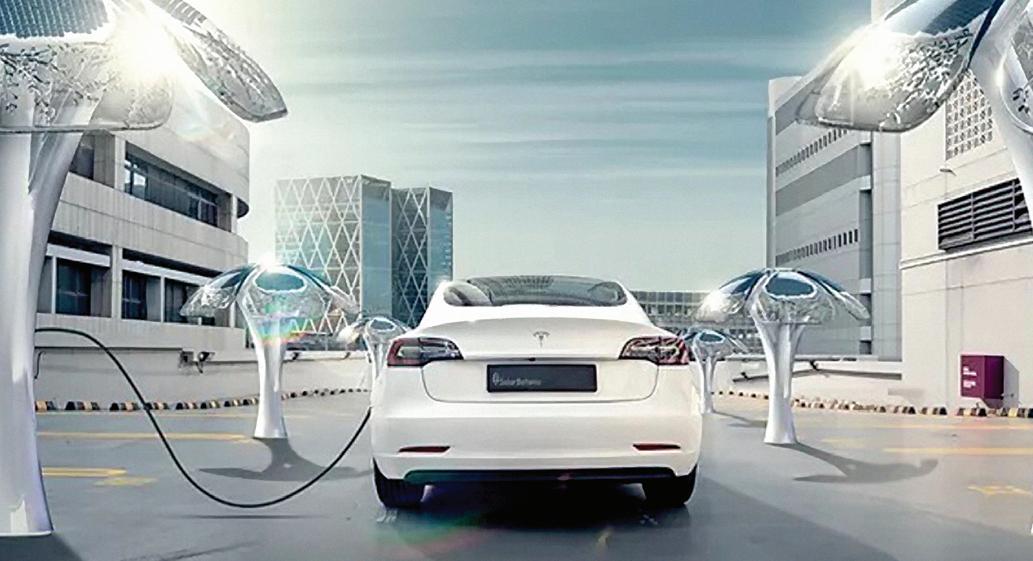
SolarBotanic developed its energy trees with Co-Innovate, a Londonbased business support programme that taps into academic and innovation resources at Brunel University London, the Manufacturing Technology Centre (MTC) in Coventry, and the University of Sheffield
Advanced Manufacturing Research Centre’s Design and Prototyping Group. Sheffield University’s centre will test SolarBotanic’s solar tree prototype.
The company has designed the solar trees to feed harvested power into an AI-driven energy storage and management system (EMS). That EMS will regulate and release the power.
SolarBotanic Trees says its firstgeneration solar tree will be available in early 2023, and the company asserts that it will be affordable once it’s mass produced.
A further funding round is planned in the first half of 2023 to fund the commercial production startup and scale to commercial volumes over the following 36 months.
Vital EV Solutions will supply charging infrastructure for Be.EV charging hubs in Greater Manchester and the north of England.
Be.EV has opted for Vital EV’s hub-and-spoke charging system, which consists of the Kempower CSeries Centralised Power Unit (CPU) and S-Series satellite charging posts, for its ultra-rapid charging speeds and class-leading power-to-footprint ratio.
Alex Rae, business development manager at Vital EV, said new hubs will also ‘look’ and ‘feel’ different.
Design for a Be.EV charging hub
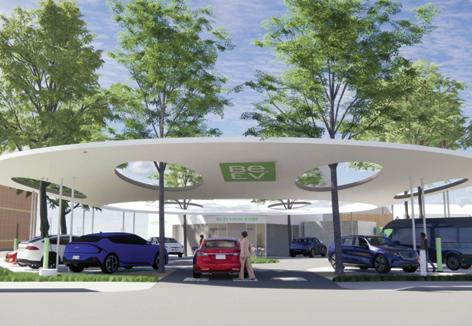
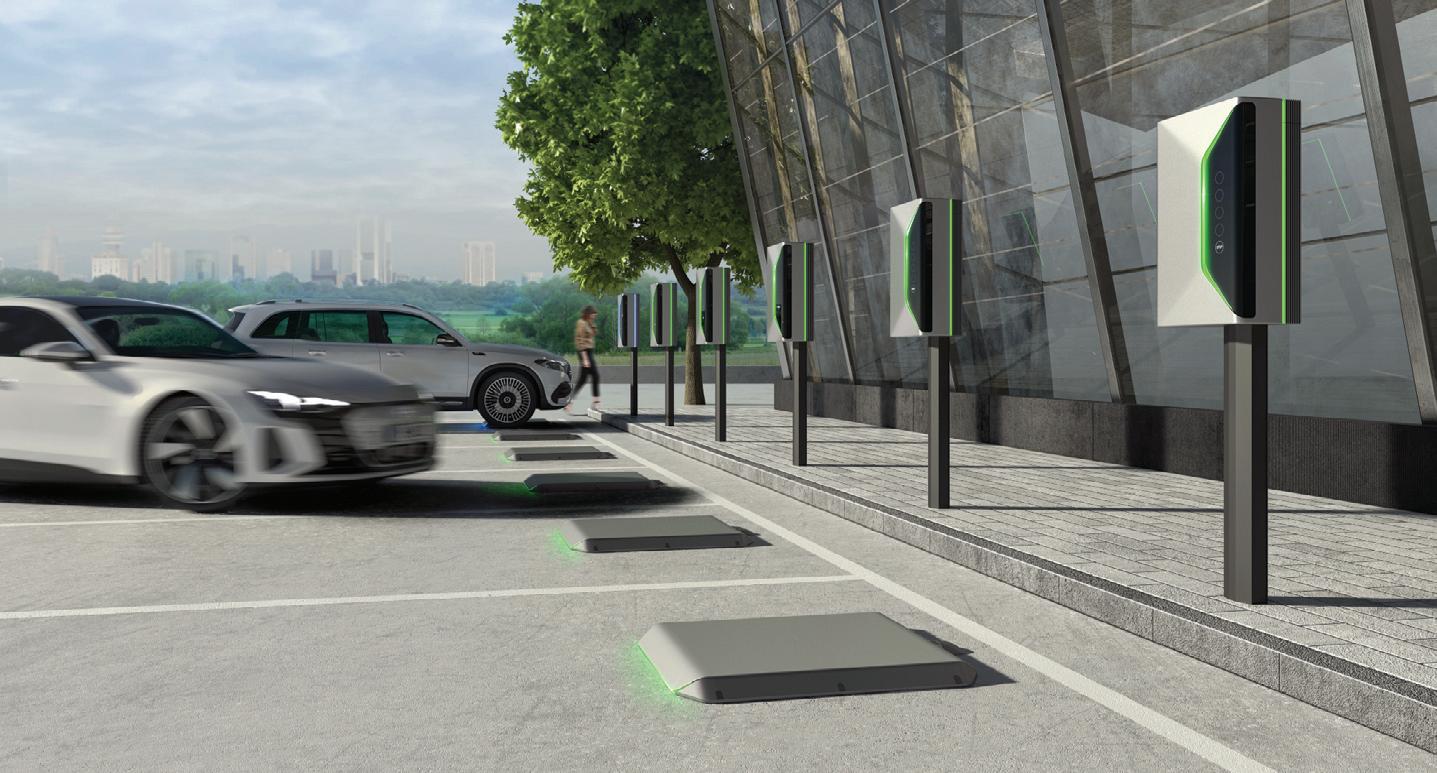
Siemens and MAHLE agree to develop inductive charging for electric

Sponsored by:


Traffic and parking management teams provide an essential service. They keep our towns and cities moving. They work to provide sufficient, equitable and safe access to the kerbside for residents, shoppers, businesses, people with disabilities and the emergency services.


Local authorities and their partners are focussed on reducing traffic congestion, ensuring the free movement of public transport and safety of pedestrians. They are increasingly key to enabling active travel, as well as implementing schemes that reduce vehicle-related pollution and delivering electric vehicle charging infrastructure.


Supported by:

Traffic + Parking 2022 will examine themes such as:
l Civil parking enforcement
l Moving traffic regulation
l Event traffic and parking
l Clean air schemes
l Parking payment services
l Kerbside management
l Signs, lines and TROs
l Low Traffic Neighbourhoods
l School streets
l Electric vehicle charging
l Mobility hubs

l Pavement parking
l Residential and permit parking
l Public consultation
l Blue Badges
l Cycle, e-bike and e-scooter parking
l Road user charges
The Traffic + Parking events attract senior parking and traffic managers, transport planners and urban professionals, including:
l Local authority officers
l Councillors and stakeholders
l Parking operators and contractors
l System and service suppliers

l EV charging specialists
l Shared mobility and car club providers
l Academics
l Consultants
l Campaigners
Local Authority
Private Sector
The event will feature presentations by:
l Jason Barbour, Managing Director, Barbour Logic
l Adam Bunce, Managing Director, 2020 Consultancy
l Joseph Burbridge, Assistant Parking Director, Project Centre
l Chris Durban, Technical Director for Transport, Project Centre
l Steven Foster, Team Leader, Parking Services, Newcastle City Council
l John Galsworthy, Assistant Parking Director, London Borough of Hammersmith & Fulham
l Mark Fanneran, Head of Service Development, Parking Services, London Borough of Hammersmith & Fulham
l Tina Glover, Associate Director, Project Centre
l Caroline Hamilton, Chief Adjudicator, Traffic Penalty Tribunal
l Victoria Hull, Head of Business Development, Debit My Mobile
l Andrea Jones, Director of Strategic Accounts, NSL
l Oleseni Koya, Associate Director for Parking, Project Centre
l Anjna Patel MBE, Principal Officer, Parking and Safer and Sustainable Transport Team, Sandwell Metropolitan
l Nick Ruxton-Boyle, Director of Environment, Marston Holdings
l Rob Shoebridge, Group Manager, Traffic & Transportation, Derby City Council
l Sharon Silcock, Head of Business Development for ZatPark, Unity5
l Darren Stoneman, Civil Enforcement Manager, Plymouth City Council
l Andy Stott, Sales Director, RingGo
l Keiran Taylor, Lead Consultant, Electric Vehicles, Project Centre

l Richard Williams, Co-founder and Director, Transfer 360
l Alan Wood, Strategic Account Director, Just
£125 + VAT
£245 + VAT
Traffic + Parking 2022 provides your company with the perfect opportunity to carefully target the marketing of your products and services to those within the smart city planning, active travel, intelligent mobility and parking sectors. Book


The British Parking Award celebrate the best the sector has to offer
There is a lot to celebrate this year. It is the 20th anniversary of the British Parking Awards, a competition launched by Parking Review in 2002 to recognise excellence and achievement in a sector that provides what is an essential public service.
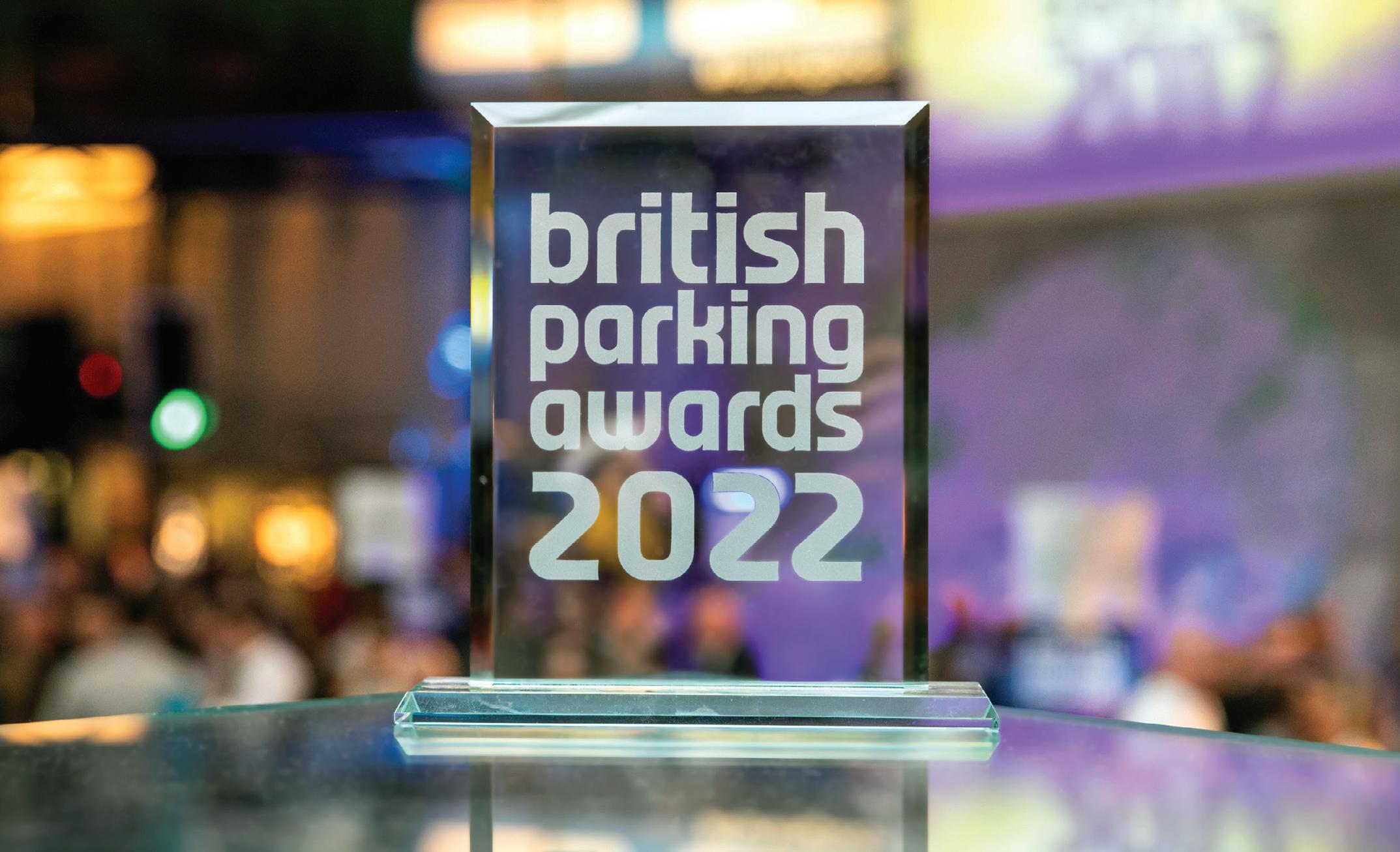
This year we received over 120 entries from across the on-street and off-street parking sectors. Over the summer, our jury of independent-minded experts has assessed and debated the entries to select the finalists.


The winners will be revealed at a gala lunch at the Royal Lancaster London on 19 October. The ceremony had been due to take place in September, but organiser Landor LINKS decided to reschedule the event as a mark of respect to the late Queen Elizabeth II.
The anniversary lunch, which sees over 650 people from across the public and private sectors gather together, is the social highlight of the traffic and parking sector’s calendar. I hope to see many of you to mark two decades of the British Parking Awards.
Mark Moran is editor of Parking Review magazine and co-founder of the annual British Parking Awards

Comedian and actress Kerry Godliman will host the British Parking Awards 2022 ceremony. Charmingly straight-talking and quick-witted, she is one of the country’s best performers.
www.britishparkingawards.co.uk
Sponsored by: RingGo
John Galsworthy, assistant director for parking services, London Borough of Hammersmith and Fulham
Dan Hubert, founder and chief executive officer, AppyWay Barry Johnson, senior technical director, Taranto Systems
Jade Neville, head of user experience, Conduent Transportation
Sarah Randall, assistant director, London Borough of Newham
Sponsored by: Solutionlabs
B4 Parking
EF International Parking Services
Q-Park
YourParkingSpace
Sponsored by: CDER Group
Parking service, City of Lincoln Parking team, London Borough of Newham
Parking, fleet and transport operations, Nottingham City Council Parking services, Royal Borough of Kensington and Chelsea Team Comet, Landside Operations, Stansted Airport
ZatPark client services, Unity5
Liveable Places traffic order team, WSP
Sponsored by: Compleo Charging Solutions UK
The Glass Works MSCP, Barnsley – Barnsley Metropolitan Borough Council, Henry Boot Construction and StructureCare
Q-Park City Hospital, Birmingham – Sandwell & West Birmingham Hospitals NHS Trust and Q-Park
Stourton Park & Ride, Leeds – Leeds City Council and BAM Nutall Northwick Park, London – London North West University Healthcare NHS Trust, APCOA Parking and HUBER Car Park Systems
Luton & Dunstable University Hospital Car Park, Luton –Luton & Dunstable University Hospital and HUBER Car Park Systems
Broad Marsh Bus Station & Car Park, Nottingham – Nottingham City Council and Galliford Try Construction
Watford Riverwell Car Park, Watford – West Hertfordshire Hospitals NHS Trust and HUBER Car Park Systems
Grand Central, Birmingham – Vinci Construction, Cemplas and Sika Middlesbrough MSCP, Colchester – Anglo Scandinavian Estate and Makers Construction
The Glass Works MSCP, Barnsley – Barnsley Metropolitan Borough Council, Henry Boot Construction and StructureCare
B4 Car Park, Birmingham
Regent’s Park Car Park, London – YourParkingSpace
Westfield London and Westfield Stratford City – EF International Parking International
Broad Marsh Bus Station & Car Park, Nottingham – Nottingham City Council and Galliford Try Construction
Watford Riverwell Car Park, Watford – West Hertfordshire Hospitals NHS Trust and HUBER Car Park Systems
Sponsored by:YourParkingSpace
The Car Park Design Award recognises innovative practices and craftsmanship
The British Parking Awards ceremony will reveal the recipients of set of special trophies.
Presented by MiPermit
The MiPermit Inspiration Award recognises individuals and organisations that have made a significant contribution to improving parking. Inspiration Award recipients are exemplars of excellent practice that have inspired colleagues, clients and the wider parking community.
Sponsored by The British Parking Association
The Lifetime Achievement Award will be presented to a parking professional who has made an outstanding contribution to the sector over the course of their career.
Presented by Parking Review
The Special Jury Prize will be presented to an exceptional scheme, project, policy or person that the jury feels will have a positive impact on the parking sector.
Sponsored by: The International Parking Community Persistent evaders and nuisance vehicles research programme – Just and TJA
JustCharge community charging network – JustPark Parking Fraud Forum and ‘The Lambeth Way’ –London Borough of Lambeth Lewisham School Streets – Lewisham Council and Videalert The Hub, Stockton-on-Tees – Sustrans
Sponsored by: ZatPark
Annual Parking Report – East Sussex County Council Communications strategy – North Essex Parking Partnership (NEPP) Introduction of Special Enforcement Areas (SEAs) – Oxfordshire County Council
Sponsored by: Go2Sim
AppyWay – AppyWay Platform AppyWay – Traffic Suite: TROs in Haringey
APT Skidata – Mobile Pay

Barbour Logic – Challenge Writer
Compleo Charging Solutions UK – EV and parking payments
Conduent Transportation – Oxford Zero Emission Zone systems
Marston Holdings and Videalert – ANPR controls at Stansted Airport North Essex Parking Partnership (NEPP) – Park and Charge RingGo and Q-Park – RingGo AutoPay
Taranto Systems – Taranto integration with London Council’s Electronic Data Interchange
Taranto Systems – Taranto Platform as a Service
Twin – A payment solution for parking and EV charging
More finalists on next page
The Parking Rosettes will be presented to projects that have a positive impact on the wider world.
Sponsored by Bristow & Sutor and Debt Recovery Plus
Parking is an essential urban service without which towns and cities would cease to function. The award will be presented to a person, organisation or project in the UK or internationally that is fundamentally rethinking and reinventing the way in which parking is planned, designed, provided, experienced and marketed.
Sponsored by: StructureCare
Laura Bailey, business and compliance apprentice, International Parking Community
Jake England, group operating manager, North Essex Parking Partnership (NEPP)
Dominik Webster, project manager and head of quality, HUBER Car Park Systems
James West, business development executive, Unity5
Lauren Winfield, data protection and compliance manager, TRACE Enforcement Group
Sponsored by: PayByPhone
Conduent Transportation team, Oxfordshire County Council
Carol Gibson, senior parking operations officer, Lewisham Council Parking attendant team, Parking Control Management (UK)
Team Comet, Landside Operations, Stansted Airport
Hannah Olaitan, senior PCN specialist, YourParkingSpace
Sponsored by: JTR Collections Welfare Team, CDER Group
Single Contact Centre, Marston Holdings
The business unit, North Essex Parking Partnership (NEPP)
Transfer 360 ZZPS
Sponsored by: APT Skidata

Transforming EV parking in Dundee – AppyWay with MILL and Clean Streets
Safe Haven Outside Schools (SHOS) – Derby City Council and Walsall Metropolitan Borough Council
Joint special operations – London Borough of Waltham Forest, NSL and the Metropolitan Police
Great North Run parking – Newcastle City Council and the Great North Run Company
North Essex Parking Partnership (NEPP)
Launching landmark payment technology – RingGo and Q-Park
Residents’ parking permits during Commonwealth Games –Sandwell Metropolitan Borough Council and Chipside
Developing Parking as a Service – Taranto Systems and Capita
Transitioning residents towards electric vehicle take-up in Westminster – Westminster City Council, Siemens and Ubitricity
Entries correct at the time of going to press
Sponsored by Conduent Transportation
Reinventing the Street is a special award that recognises innovative approaches to managing the kerbside and wider street scene in a way that creates vibrant and healthy town and city centres.
Sponsored by DCBL
This category recognises the many ways in which parking policy, design and management practice can help improve the quality of the environment and encourage a sense of wellbeing.
The British Parking Awards 2022 will see the launch of a new award.
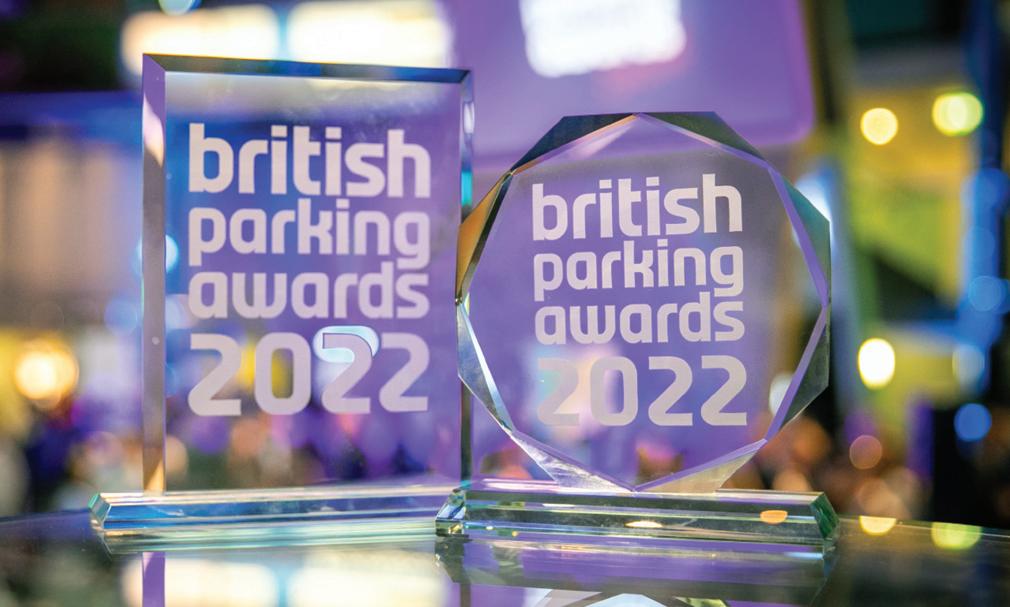
Presented by EVolution Magazine
The parking sector is playing a key role in enabling the transition to zeroemission vehicles by planning, providing and managing electric vehicle (EV) charging infrastructure in car parks and at the kerbside.
Parking Review has marked this trend by launching a website and sister magazine called EVolution. The winning EV charging initiative will be drawn from the finalists at this year’s British Parking Awards and the recipients will be announced at the ceremony.
www.britishparkingawards.co.uk



Revenue brought in by Nottingham’s WPL has topped £90m, unlocking £600m of other transport investments

Whatever the colour of the administration, council after council report the same problem: There are too many cars on the roads, choking up towns and cities with vehicles dirtying the air and contributing to climate change. The issue is holding local economies back from reaching their potential because goods and services get caught up in the congestion. Christopher Hammond writes
Councillors of all parties have faced the same difficulties when trying to make a big difference in how people get around. Council leaders have to square the needs of residents of all backgrounds, employers of all sizes, and the views of their councillors. The how of it all, therefore, is the key. What is the best tool for tackling congestion and, in so doing, cutting the carbon emissions and air pollution caused by transportation?
If you exist outside local government circles, you might not have heard about Nottingham City Council’s workplace parking levy (WPL). Widely regarded as one of the UK’s most successful green transport interventions, this charging scheme for employerprovided parking is now over a decade old. And, by all accounts, it has been a big success. Which begs the question: why has no council followed suit yet?
UK100 is aware of at least ten local authorities actively reviewing similar schemes, with Leicester and Oxford as the closest to implementing their own workplace parking levy.
Two UK100 consultants are supporting the development of the WPL concept right now, with one working with Oxford City and Oxfordshire County Councils and another working with Leicester City Council. The support comes on the back of a UK100 mem-
bers-only summit convened to learn more, share findings and offer practical assistance. We’re learning a lot and will share more in the coming months. In the meantime, this is a primer on WPL based on what we have learned.

In the year of the Millennium Bug, the Concorde crash, and the launch of the Playstation 2, the Blair government gave councils with transport responsibilities the power to implement a workplace parking levy. The Transport Act 2000 enabled local authorities to charge employers for parking spaces provided to employees driving to and from their workplace.
Nearly ten years after empowering local government, Nottingham City Council took the plunge. Like many cities, Nottingham’s citizens were experiencing worsening congestion and poor air quality because their transport infrastructure privileged the car above all else.
Modelling completed in 2007 highlighted that work-related transportation was to blame. Some 70% of traffic at peak periods came from people commuting to work. Surprisingly to some, this work-related transportation was actually harmful to the economy: congestion left £170m of avoidable costs each year in terms of lost economic growth.
The WPL hoped to limit the economic damage of work-related
Nottingham’s workplace parking levy
regarded as
of the UK’s most successful transport interventions Christopher Hammond
transport by shifting employees out of their cars onto public transport, a bike, or their own two feet. And the scheme has been an economic boon. Despite the usual predictions of economic doom, and threats of an exodus of companies and jobs, all of which can cause anxiety for councillors who want to do the right thing, none of these warnings came to anything.
Within the first five years of the WPL, Nottingham saw a 22.2% boost in the number of businesses opening up in the city, with a real-term job increase of 23,400 and a 44.8% fall in unemployment. Moreover, the WPL can be good news for councils that have only known tough times because of austerity and the pandemic and are now facing the impact of inflationary pressures on their operations and services. For cash-strapped councils short of opportunities to raise new money, a WPL could be a lifeline – even if it is ring-fenced for transport projects.
The revenue brought in by Nottingham’s WPL has topped £90m, unlocking £600m of other transport investments. Operationally, officers have run an efficient service achieving 99.9% of revenue collected, no penalty charge notices issued and operational costs of less than 5%.
The WPL has funded two new tram lines and an extra 17.5km of track. And Nottingham Station has been transformed into a 21st-century integrated transport hub, supporting routes on the Link Bus Network.
The sustainable transportation investments made possible by the WPL have enabled the city council to meet its other ambitions. Four in every ten pre-COVID journeys to work were by public transport, resulting in carbon emissions falling by a third since 2005. Meanwhile, congestion growth has been slashed by 47%.
If the WPL is such an obvious win-win, why has no other council utilised the powers in more than two decades? One reason is a political appetite to do what works and what the evidence shows is needed.
In July, UK100 convened a confidential roundtable event with two authorities looking to implement a WPL in the next two years. Leicester City Council has completed a public consultation on a planned scheme. Oxford City and Oxfordshire County Councils are next. Leicester and Oxford Councils joined the call to explore the opportunities and challenges of implementing a WPL with the direct expertise of those who know how to do this: Nottingham politicians and officers.
UK100 is a network of local government leaders which seeks to devise and implement plans for the transition to clean energy that are ambitious, cost-effective and take the public and business with them.
The organisation supports decision-makers in UK towns, cities and counties in their transition to net zero. It is the only network for UK local leaders focussed solely on climate, clean energy and clean air policy.
For example, the UK100 Net Zero Local Leadership Club is working to get their communities to net zero as soon as possible, and by 2045 at the latest.
To accelerate the transition to a net zero society, UK100 brings together local authorities across the country to share knowledge, collaborate, and petition the UK government with their collective power. www.uk100.org
The worsening economic climate may make politicians cautious and hesitant to take steps that might be controversial or, more accurately, misinterpreted or misconstrued as harmful. But the cost-of-living crisis is the perfect time to explore schemes that can unlock jobs and growth.
And when our summer has seen two extreme heat waves, we cannot afford to be tinkering at the edges anymore. The climate crisis is here. Without the ambition and action of local government, we’re not going to hit the UK’s climate targets. And if we miss those targets, our entire way of life will change far more radically than it might under the WPL.
UK100 sets out ways of ensuring that local communities see the benefits of WPL schemes
To avoid the deadly sin of leaving communities out in the cold, councils need to employ the seven capital virtues to successfully implement a workplace parking levy:
1. Develop a clear narrative and rationale for change, which can be communicated simply to a large, diverse audience. What is the case for change, and what will people get out of it?
2. Nurture political investment throughout the project’s lifetime. It’s not enough to get political support going at the beginning. If political support falls, so does the scheme.
3. Build a rapid rebuttal unit. In an age of social media, where post-truth populism can be most effective, councils must control the narrative. They must ensure their citizens can access trusted and accurate information to make their own minds up, rather than see fears whipped up and consultation responses distorted by those who are most wedded to frustrating change.

4. Invest in building a coalition of community groups, businesses, and residents who want the change, and make sure that they vocalise their support. Too often allies and supporters sit out fights, believing that their support of a council won’t add much weight to influencing the change positively.
5. Engage with critics or people who have legitimate issues and concerns that they communicate reasonably and responsibly. Do not dismiss concerns out of hand because then you’re dismissing the person raising the concerns and making an enemy out of a potential ally.
6. Negotiate, and be open to compromise. Sensible exemptions can be negotiated. But don’t create so many exemptions in the spirit of pleasing everyone that you render the whole scheme meaningless.
7 Make WPL a priority. Councils must recognise that implementing a WPL cannot be done as a side of desk activity but seen as a key project with full corporate support.
is widely
oneChristopher Hammond is UK100 membership director, the leader of the WPL summit and the former leader of Southampton Council


cores were protected but the main steelwork to all floors was bare. The reporter believed that on a new build development the structure of the car park above the retail area should have at least a minimum of a 30-minute fire resistance rating.
Building a steel-framed car park without structural fire protection produces a number of possible risks as this creates the potential for the parking decks to collapse when the frame is exposed to extreme heat. This situation poses a threat to life and other property. These are among the findings of a report produced by a structural safety watchdog. Collaborative Reporting for Safer Structures (CROSS UK) is a confidential reporting system that captures and shares lessons learned from fire safety and structural safety issues. The body was formed by the Institution of Structural Engineers (IStructE) and Institution of Civil Engineers (ICE) to help professionals to make structures safer. It does this by publishing safety information based on the reports it receives and information in the public domain.
CROSS publishes regular bulletins that flag up its analysis of concerns raised by ‘reporters’. The report on the fire safety issues on one particular steel-framed car park was carried in CROSS Newsletter 66, which was published in September.

A construction industry profession who was concerned about the levels of structural fire protection in multi-storey car parks reported their worries to CROSS. This concern was specifically raised about the possibility that a car park was to have no structural fire protection and this facility was to be constructed above two levels of retail units.
The anonymous reporter has worked on many car parks in the construction stages to completion. They recently worked on a development in a UK city where the steel frame of the lower retail floors was constructed with fire protected steelwork, but the seven floors of the car park above the retail unit had no such protection to the load-bearing steelwork.
CROSS was told that the steelwork to all floors, including the entrance on a circle ramp, had no protection and the structural elements were just galvanised steel columns and beams. The stair
The CROSS expert panel recognises the potential for concern regarding the topic of car parks, and addressed the issue in the SCOSS Alert on Fire in Multi-Storey Car Parks. The panel writes: “The conventional technical guidance in Approved Document B (ADB) for 15 minutes fire resistance for the steelwork in open sided car parks can intuitively ‘feel’ inadequate. The rules for fire resistance of car parks are largely based on the assumptions that single-car fires, rather than multi-car fires, occur and the idea that a fire will be less intense in well ventilated spaces. This was based on tests on cars from the 1960s that had very little combustible material on the outside, were smaller, and tended to have a lower fuel load. It should be noted, however, that it is guidance which has been in place for many years, and so presumably there are many car parks built to that standard.”
The panel writes that, to the best of its knowledge, there are no significant incidents of fires in open sided car parks which caused major structural failure. The experts say: “The possibility of multi-car fires was demonstrated by research in 2010 (BRE report BD2552) and in real events such as the Liverpool Arena car park fire which also highlighted the risk of fire spread to other cars and adjacent structure.”
Fire risks within car parks are changing, says CROSS. “The nature of the fire load is evolving and this can affect the fire size and heat release rate,” the experts wrote. “In addition, the increased use of electric vehicles (EVs) could also affect the risk of fire spread to multiple cars due to the characteristics of EV fires (especially the directional jet flames), invalidating the assumption of single-car fires. There are also concerns about the likelihood of dead spots where heat can accumulate, for example in corners or complicated geometries, a fact which will locally undermine the assumption of a well ventilated fire. These changing conditions might suggest that the historic guidance might be inappropriate in some cases, which is why this topic was included in the call for evidence for the revision on ADB and is therefore under review.”
Safety watchdog flags up concerns about the lack of fire protection on a steel-framed car park built above a retail unitFire spread between decks in the Liverpool Arena car park fire
CROSS says that safety requires a look at the whole. It states that Building Regulations through Regulation 8 clarify that they cover “the purpose of securing reasonable standards of health and safety for persons in or about buildings (and any others who may be affected by buildings, or matters connected with buildings)”.
In the case of the car park project that has been reported, CROSS UK states: “Whilst it may be reasonable to expect an open-sided car park to be evacuated relatively quickly, it seems unlikely that the retail floors below would be if failure of the car park compromised the retail structure below. This would be defined by any consideration of the protection to the structure below the car park levels and whether it is designed as a crash deck in the event of collapse and its capable of shedding the volumes of water that would be used in the event of a fire. If no such consideration is provided, then the structure would not protect the people within the building and so would not comply with the regulations – regardless of how ADB was interpreted. One potential (conservative) approach could be that the whole structure should have protection to the level of the greatest need. Similarly, the building appears to be relatively tall with seven floors of car parking on top of retail floors.”
It is not known to CROSS what structures were surrounding the car park. “If this is in a densely built area then these could represent the greater fire risk if there is a possibility of the fire spreading from a multi-car fire in the car park to adjacent buildings, or that a structural failure could also impact adjacent buildings. This again indicates a failure to meet the building regulation requirements of protecting people about the building.”
The report on the car park overlaps with a CROSS report on battery fires. CROSS states that vapour cloud explosions have been reported with EVs, reinforcing the stated view of some parties that ADB does not consider the risk posed by modern vehicles and certainly does not consider the risk from EVs. This leads to CROSS to suggest that car parks containing EVs maybe should not be considered a “common building situation” as described in the Manual to the Building Regulations.
CROSS states: “Obvious concerns also exist over firefighter safety when entering these structures, and it should be acknowledged that if the ‘Officer in Charge of an Incident’ has any doubts to the safety of the structure, then they may well decide to not commit to the structure and fight the fire defensively.
“Absolute reliance on codified provisions can potentially be inadequate as an approach, especially when the codes are conceived for circumstances that differ from the reality at hand. What is needed is a full rational understanding by the designer of the risks and their control measures.”


CROSS notes that additional guidance on car parks can be found on the website of the Steel Construction Institute, and in the publication by the Institution of Structural Engineers (IStructE) titled Design recommendations for multi-storey and underground car parks (Fourth edition). The IStructE guide is currently under review, and it is the panel’s view that, until any updated guidance is available, there is a need for caution with the figure of 15 minutes of fire resistance rating. CROSS suggests that a competent fire engineer is employed when this is proposed without meaningful consideration.
www.cross-safety.org/uk
• Be aware that a multi storey car park structure designed to a fire resistance rating of 15 minutes may not satisfy the functional requirement of the building regulations
• Structures should be designed so that in the event of a fire they remain in a safe and stable condition to allow firefighters to safely enter the building, while also ensuring the safety of the people around the structure
• Be aware of past failures and take them into account when designing or altering similar structures.
CROSS UK advises facility managers to ensure plant water feeds are kept switched on
Green walls and roofs add to the aesthetic and environmental benefits of buildings, but if not managed properly they may inadvertently pose a fire risk, a safety watchdog has warned. CROSS (Collaborative Reporting for Safer Structures) said that building close down procedures such as isolating automated water systems might result in the drying out of green walls, which could then present a significant fire hazard in external walls.

“Green roofs and living walls are increasing in popularity,” CROSS wrote in an advisory note released last year. “Green walls are often irrigated by an automatic timed water feed switch system. However, building close down procedures that include isolating electrical/water supplies or branches might switch off watering systems, resulting in the drying out of green walls and thus presenting a fire hazard in the external wall. If the vegetation is allowed to dry out, it may become a fuel for fire.”
CROSS pointed out that guidance regarding fire safety measures has been published by HM Government and by the National Fire Protection Association (NFPA).
However, the CROSS Safety Report ID: 976 stated that external walls are not routinely covered in fire risk assessments and are not considered a separate compartment in structural fire safety terms due to the likelihood of fire spread through window openings.
A CROSS expert panel commented: “There is greater pressure through planning for green walls, for reasons of biodiversity, urban heat island effect and wellbeing. Planning will often require the maintenance of the planting, for visual reasons, but when approving for building regulations irrigation is a critical factor. Any system which is important to safety needs to have appropriate measures in place to allow for maintenance, or for breakdown. It is probably not currently on people’s radar that irrigation may fall under the same category as sprinklers or fire alarms, so fire strategies and fire risk assessments need to reflect its importance.”
Key learning outcomes for building owners, managers and occupants:
• Be aware of the need to maintain water supplies to vegetation that does not have access to groundwater through the roots.
• Risk assessors should be aware of this issue and when assessing buildings with this feature andadvise Responsible Persons accordingly
• The Fire Safety Act 2021 clarifies that the external walls and any attachments should be considered as part of the fire risk assessment.
later once if vehicular access is no longer needed.
When designing a new building, it is not usual for developers, architects and engineers to give a lot of thought to what happens should the project eventually become redundant. However, this is exactly the approach taken by the team creating a multi-storey car park in Calgary, Canada. Anticipating its future redundancy, the design and client team have created a parking garage that actively contributes to the public realm and can be easily converted into an office, light industrial or residential building. The City of Calgary in Alberta required a downtown ‘parkade’ to free up multiple lots for development. Understanding the likelihood for the building’s future obsolescence, municipal officials also wanted a creative solution that would justify the expenditure now and in the future.
So the clients, Calgary Municipal Land Corporation and the Calgary Parking Authority, asked the collaborative team of Kasian Architecture, Interior Design and Planning, and 5468796 Architecture to design a 510-bay multi-storey garage that could be easily converted into an office, light industrial or residential building.
The 9th Avenue Parkade + Innovation Centre project site is located adjacent to the new Calgary Library, Calgary City Hall and the Studio Bell, the National Music Centre. It included an unbuildable easement for an underground light rail tunnel which cuts through the middle of the project site and represents what the city determined was a 20% loss in buildable area.
The design team’s solution has been to create a building in the form of an elliptical helix, bridging the easement and thereby recapturing much of the lost land value. Vehicles enter at grade, directly over the easement. The ellipse creates a large, street-width interior courtyard with 12-metre shallow floor plates that allow daylight and ventilation to pervade the interiors from multiple directions, a critical feature should the structure be converted to a new use. The floor plates ascend on a 1-2% gradual slope to avoid the need for vehicular ramps that would eventually need to be removed. Ceiling heights of 4metres, clear spans, and universal load-bearing capacity contribute to a variety of gradual or wholesale changes with low-cost ramifications.
The vehicular entrance, with clearances that will allow for maintenance of the underground tunnel, is flanked by pedestrian and bicycle entrances and activities such as a basketball court, activating the frontage along 9th Avenue SE and framing the southern edge of the developing East Village neighbourhood. Spherical bollards, coloured concrete patterns on the floor, and a traffic mirror ceiling ensure the central courtyard is a lively and vibrant place with a distinctive and memorable aesthetic, enriched by additional public amenities including a cafe patio and an outdoor exhibition space.
The structure is enveloped in a distinctive guard façade that is raised strategically around the perimeter to provide pedestrian, bicycle, and vehicular access. The members of the façade hold a fine-grained mesh that acts as a pedestrian guardrail. The aim is that this can easily and inexpensively be converted into residential/commercial suite balconies with no additional work required.
Joanne Sparkes, project architect at Kasian Architecture, Interior Design and Planning, says: “Halfway into the design process, the client firmed up a partnership with Platform, an entrepreneurial hub for the city’s burgeoning innovation community. This was the first test of the adaptable design – requiring conversion of the plan into an open and flexible office space that can be easily modified for use by individuals and small and large groups, and occupying the space on an hourly, daily, monthly or yearly basis.”
The design team proposed that Platform occupy the first two levels of the building to animate the street frontage. By suspending a lightframed vehicular ramp that cuts through the central courtyard, the vehicular circuit was removed from within the structure. The ramp also offers drivers an unexpected user experience. It can be easily removed
Sasa Radulovic, founding partner at 5468796 Architecture, says: “Inside, Platform is imagined as a space ripe with opportunities for work and collaborative potential. Its relatively raw and generic 4,500 square meters can be adapted and appropriated by tenants at will — even for light industrial use. The nexus connecting the two levels is a pitch stage that cuts through the second floor, connecting the principal entrance with both floors and encouraging both organised and impromptu meetings.”
The space is designed to enable evolution over time. An ‘infrastructure frame’ hangs overhead but within reach, suspended from the ceiling to a datum at 2,400mm above the floor, to facilitate easy connections and reconfigurations, thereby providing ultimate flexibility for any layout. Beneath the infrastructure frame are generic pods that vary in openness – from fully open to closed. Users and staff can easily access power from overhead, and arrange the portable lights and mobile furniture to meet their individual or group requirements.
The succeeding six levels comprise 280,000 square feet of parking, with light-washed, pedestrian-forward routes and elevated views in all directions. Clear, simple, and single-direction circulation is explained with distinctive wayfinding – created by the architects as an extension of the building design.
In its next life, the 9th Avenue Parkade can be converted partially or entirely, gradually or expeditiously, and to one or more uses. The shallow slope provides a ‘flat’ floor within acceptable tolerances for class B or C office or light industrial space. The imperceptibly shallow spiral creates an ‘infinite’ floor plate, allowing for great flexibility in the future. Residential conversions can be achieved with a surface topping material.
Joanne Sparkes says: “Beyond providing the necessary urban infrastructure to serve the city, as well as an overarching design intention to see the structure’s use transform for the needs of the future, the design of the 9th Avenue Parkade and Innovation Centre contributes to the urban fabric of the City of Calgary in a distinct way. Engaging local photographers, car enthusiasts, and public appreciation within a key cultural neighbourhood, the project continues the district’s reputation for strong design excellence.”
Sasa Radulovic adds: “Since the opening of the parkade portion of the project, its functional aesthetic has been making regular appearances as a defining backdrop for Calgarians. It actively contributes to the public realm and to the design conversation of our cities – that conventional typologies can evolve beyond the accepted standard to provide delightful, inspiring experiences and spaces. The success of the project is the result of a diverse design and client team demanding more of the project brief and developing innovative, business-conscious solutions in order to integrate a long-term, iconic design into Calgary’s urban identity.”



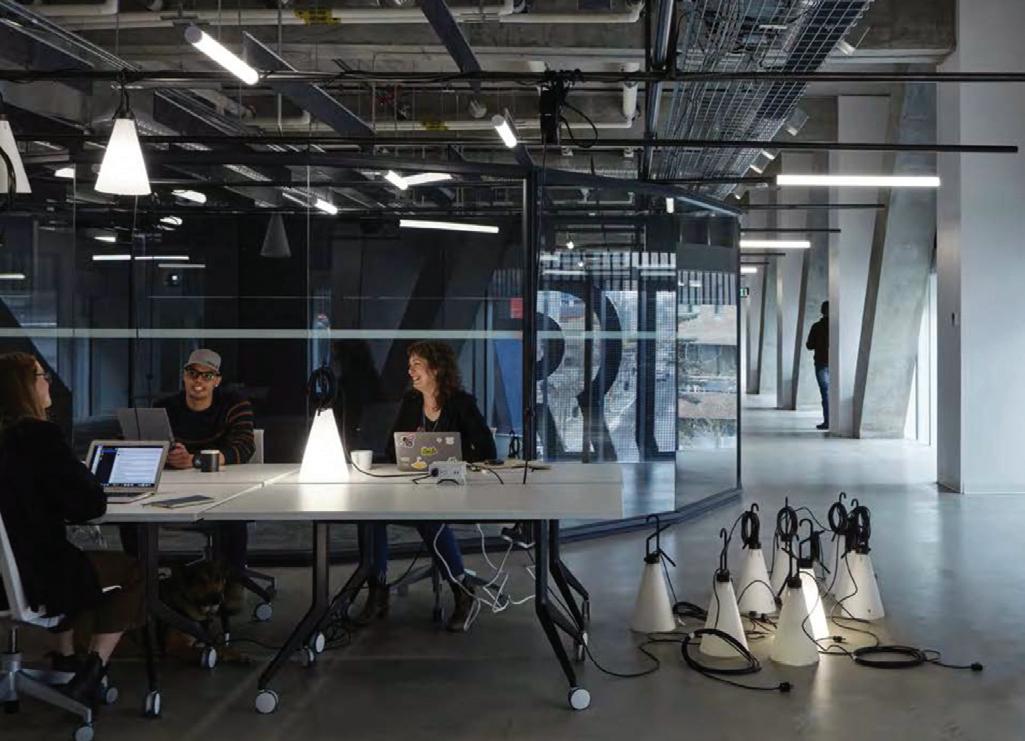


The final designs of the car park serving the Riverside Sunderland development have been revealed. The 650-space multi-storey will be a prominent gateway to what will be a new urban quarter. Making it easy for people to access the city centre is regarded as being key to the area’s success, thus, the multi-storey will be a central pillar in the wider transport and infrastructure strategy to bring the area to life.
The car park will be constructed by Sir Robert McAlpine after a competitive tender for the £14m project. Taking around 16 months to complete, McAlpine will construct the car park as well as delivering some external works including refurbishing the Galleys Gill Bridge.
The new designs by Tonkin Liu Architects for the car park have been unveiled as part of a planning variation submitted to Sunderland City Council. The computergenerated images reveal the car park will feature a mesh-wrapped building with a living wall.

Patrick Melia, chief executive of Sunderland City Council, said: “We want to ensure that every building at Riverside Sunderland reflects the level of ambition we have for this city, including infrastructure like car parks which are often the first place people see when they arrive.
“We’re really pleased with the final designs for the multi-storey car park, which are distinctive enough to stand out, but discreet
enough to ensure what will be a large building does not overtake or distract from the beautiful residential buildings that will stand close by when this site is fully developed.”

The London-based practice, co-founded by award-winning architects Anna Liu and Mike Tonkin, was asked to developed a positive, high quality contribution to the Riverside Sunderland cityscape, providing a memorable and distinctive building by day and by night.
Tonkin Liu Architects was commissioned to produce an illuminated piece of art which will light up the Sunderland night sky.
Tonkin Liu’s portfolio of projects includes infrastructure and artistic commissions such as the £1.4bn Tokyo Forum, the Cradle Towers of Zhengzhou, Manchester’s Tower of Light, the York Minster Centre of Excellence and the Paddington Willow Pavilion in London.
Anna Liu, director at Tonkin Liu, said: “Sunderland is all about the sea and we are delighted to see this important project nearing fruition. Like creatures in the sea, the comings and goings of the moving cars’ headlights and taillights will animate the two-dimensional artwork with a dynamic three-dimensionality.
“The concept has built on the heritage of Sunderland’s affinity with the sea, being once the world’s largest shipbuilding centre. This is an affinity rekindled by the city’s current role as a major gateway to offshore wind farms, shaping Sunderland’s green future.”
The multi-storey car park will serve people living and working in Riverside Sunderland, as well as visitors attending leisure venues including the Auditorium and Culture House, a £25m library and ‘community living room’.
Once complete, it is estimated that the Riverside Sunderland development will create up to 10,000 jobs and significantly boost the city centre population with the construction of hundreds of homes, providing a huge boost to footfall in the city centre by increasing the number of people visiting, living and working in it.
Provision of the car park capacity should reduce pressure on other city centre parking such as St Mary’s multi-storey, as well as ensuring additional provision is made for a surge in people heading into the city on a daily basis when more commercial office spaces open.
It is expected the car park will operate outside of normal working hours, to support the evening economy in the city centre, and will operate through a combination of pre-paid permits and paid parking.
With a commitment to sustainability on the Riverside Sunderland project, the car park will include an initial 15% electric vehicles spaces.
The car park’s position on the edge of the city centre, linked by the Strategic Transport Corridor to Sunderland communities, means it will also help reduce congestion in the heart of the city. By consolidating parking in one large facility, it is hope the car park will help to achieve a pedestrian-priority for Riverside Sunderland.
The partial demolition of a Bath council car park has started as part of the Bath Quays regeneration project.
The upper levels of the Avon Street multi-storey car park are to be removed after the discovery of extensive structural deterioration which has made the cost of remedial work unrealistic. After demolition of the upper two storeys, the ground floor level of the car park will be refurbished.

When the work is completed, the revised Avon Street car park will re-open with a total of 291 parking spaces.
During demolition, the adjacent footpath and part of the car park will be closed temporarily as a precaution and the construction site will be surrounded by hoarding.
There will be increased levels of noise and dust, but the council has agreed dampening requirements with the contractors and will be monitoring levels as the works proceed.

Cllr Manda Rigby, Bath and
North East Somerset Council cabinet member for transport, said: “This is another step in our flagship regeneration project to create a new and vibrant quarter in the heart of Bath. Once the upper levels of the car park are removed it will improve the appearance of the car park and it’s hoped there will be less antisocial behaviour around the site.”
During the work, 140 parking spaces will remain available at Avon Street and alternative short
stay parking will be provided in Green Park Road temporary car park on the former Riverside Coach Park. Long-stay parking will be available in nearby Charlotte Street and Manvers Street car parks.
The council said work on the construction of a new two-storey underground car park will start in 2023 as part of the Bath Quays regeneration scheme. It will include up to 320 public parking spaces.
A brutalist shopping centre and its car park in Bradford are to be demolished. The Kirkgate Centre, which has been bought by the council for £15.5m, will be replaced with housing, commercial premises and green space.

Kirkgate opened in 1976 as the Arndale Centre. It currently has 46 shops and food and drink businesses, including Boyes, Sports Direct, New Look and Primark.
In recent years, the centre has suffered from a high number of vacant units, partly due to competition from The Broadway, which opened in 2015.
Ben Middleton, Bradford Council’s assistant director of estates and property, said the centre was not expected to close in the immediate future. Middleton said the city is planning to focus its retail offer in the area of the Broadway. Primark is planning to relocate into Broadway. It is expected many others will follow.
Upper two levels will be removed after deterioration
Queen Elizabeth Hospital’s MSCP will be built in two phases
The Queen Elizabeth Hospital (QEH) in King’s Lynn has published plans for a multi-storey car park to support its case for a new hospital. The project is being undertaken by The Queen Elizabeth Hospital Kings Lynn NHS Trust, which serves communities in West Norfolk, South Lincolnshire and East Cambridgeshire

The car park is an integral part of the plans to bring a new hospital to King’s Lynn and West Norfolk. It will help to address
ongoing parking challenges and improve the experience of patients, visitors and staff.
Ensuring that there is adequate car parking during the building works and once the new hospital is open is a particular focus for QEH as part of ensuring it is ‘investment ready’ for securing government funding as part of the national New Hospital Programme.

Laura Skaife-Knight, deputy chief executive of QEH, said: “To secure the £862m of government funding we need for a new hospital, we must show we have plans in place to address any disruption that a major build on our existing site could bring by providing adequate car park-

ing both during the building works and once the new hospital is open.”
QEH said its car park proposal is in line with the majority of new hospital schemes across the country which include plans for multi-storey car parks, recognising that for patients, visitors and staff, good access to parking has a significant impact on their overall hospital experience.
The multi-storey would be built using the ‘Modern Methods of Construction’ principles that guide all NHS new builds. QEH’s developing plans for the car park include: space to access vehicles for patients with reduced mobility; energy efficient LED lighting; a wheelchair area; natural ven-
The new Broad Marsh Car Park, Bus Station and Central Library building has won a construction industry award. The project was named the Overall Winner after winning the Sustainable Development of the Year and Commercial Development of the Year prizes at the East Midlands Bricks Awards 2022.
Built by contractors Galliford Try on behalf of Nottingham City Council, the development replaced an 1970s car park and bus station with a new building containing a multi-storey car park, new bus station, double-height Central Library and retail space surrounded by public realm.
The landmark development is a key element of the £2bn regeneration of Nottingham’s Southside.
The Sustainable Development of the Year recognises the council’s
tilation; and a 24-hour CCTV.
There will be spaces for patients, visitors and staff to charge electric vehicles, with flexibility to increase provision for electric charging points.
The car park would be built in two phases:
• Phase one will see a new car park to serve the current hospital (in addition to the existing main car park). This is required now as demand is currently higher than available spaces. This phase will be developed in such a way that the initial phase one car park can remain operational while phase two is being built • Phase two will follow when funding for a new hospital is announced).
ambition for Nottingham to become the first UK carbon neutral city by 2028. Broad Marsh has 81 electric vehicle charging points and 720 roofmounted solar panels to power the car park and bus station, energyefficient lighting and a vehicle management system to navigate drivers to free spaces quickly, reducing vehicle emissions. Also 95% of the demolition material was recycled into the new building.
The Commercial Development of the Year trophy recognises how the scheme contributed: more than £30m of economic value to the city during construction; effective collaboration between contractors, the council and other partners; best practice design; and rising to the challenges of the COVID pandemic striking shortly after start of the project.
Manchester’s historic Great Northern Warehouse site, which is partly used as a car park, is set to be redeveloped.
Trilogy Real Estate and Hong Kong-based Peterson Group are bringing forward plans that will involve creating 750 homes across three buildings – including


a 32-storey tower.
The developer has launched a public consultation on its proposals for the Great Northern site, four years after an earlier iteration of the plans was approved. Since then, Manchester City Council adopted a strategic regeneration framework for the area.

Trilogy’s fresh vision for the site, designed by SimpsonHaugh Architects, seeks the demolition
A former John Lewis department store and car park at risk of demolition has been granted Grade-II status.

Opened in 1963, the former Cole Brothers store in Barker’s Pool later became a John Lewis. In 2020 the retailer had surrendered its old lease for the site to the council for £3m. In return, the firm was granted a new 20-year lease at a lower rent. However, it was one of eight stores closed by John Lewis during 2021.
Following the closure of the store in 2021, leaseholders Sheffield City Council launched a public consultation to decide what should happen to the structure. Options included

reusing the structure, demolishing it to provide a large public space or replacing it with a smaller building and connected public space.
This summer demolition of the 400-space multi-storey car park was announced as a way of making the site more attractive to developers and reduce the number of vehicles in the city centre. A reprieve arrived after the building and architecture was recognised by Historic England. The store was designed by Yorke Rosenberg and Mardall and is described as “a rare example” of a postwar department store designed by a leading architects’ firm.
of the 1990s addition to the warehouse, which currently houses an Odeon cinema and an NCP car park. The residential element of Trilogy’s proposals will be built on the site of the 1990s extension.
Three residential buildings will be constructed on the cleared site. They will be 112 metres, 92 metres and 52 metres tall. The neighbouring Beetham Tower is 152 metres in height.
The Grade II star-listed warehouse will be refurbished as offices. This marks a change from the earlier proposals, which sought to convert the building into apartments.
Trilogy has also been working with landscape architect PlanitIE on plans to revamp the square that fronts the warehouse.
Subject to planning approval, construction is expected to start in late 2023, according to Trilogy.
WPS and Prestop showcase interoperable touchscreen solutions
WPS Parking Solutions is working with Prestop, a manufacturer of touchscreen terminals, to showcase interoperable systems.
Prestop has become the first hardware producer to partner with WPS’s cloud-based paperless parking management solution. Prestop’s indoor payment kiosks will be powered by WPS’ parking management system ParkID. Branded as ‘Prestop Powered by WPS’, the kiosks will join other software and payment partners already live within the WPS Parking Platform.
The WPS and Prestop partnership will cover both new parking installations and existing sites where WPS’ ParkAdvance equipment is already installed.
As a certified ParkID partner, Prestop will provide four of its high-volume indoor payment kiosks as options for the parking market. These include free-stand-
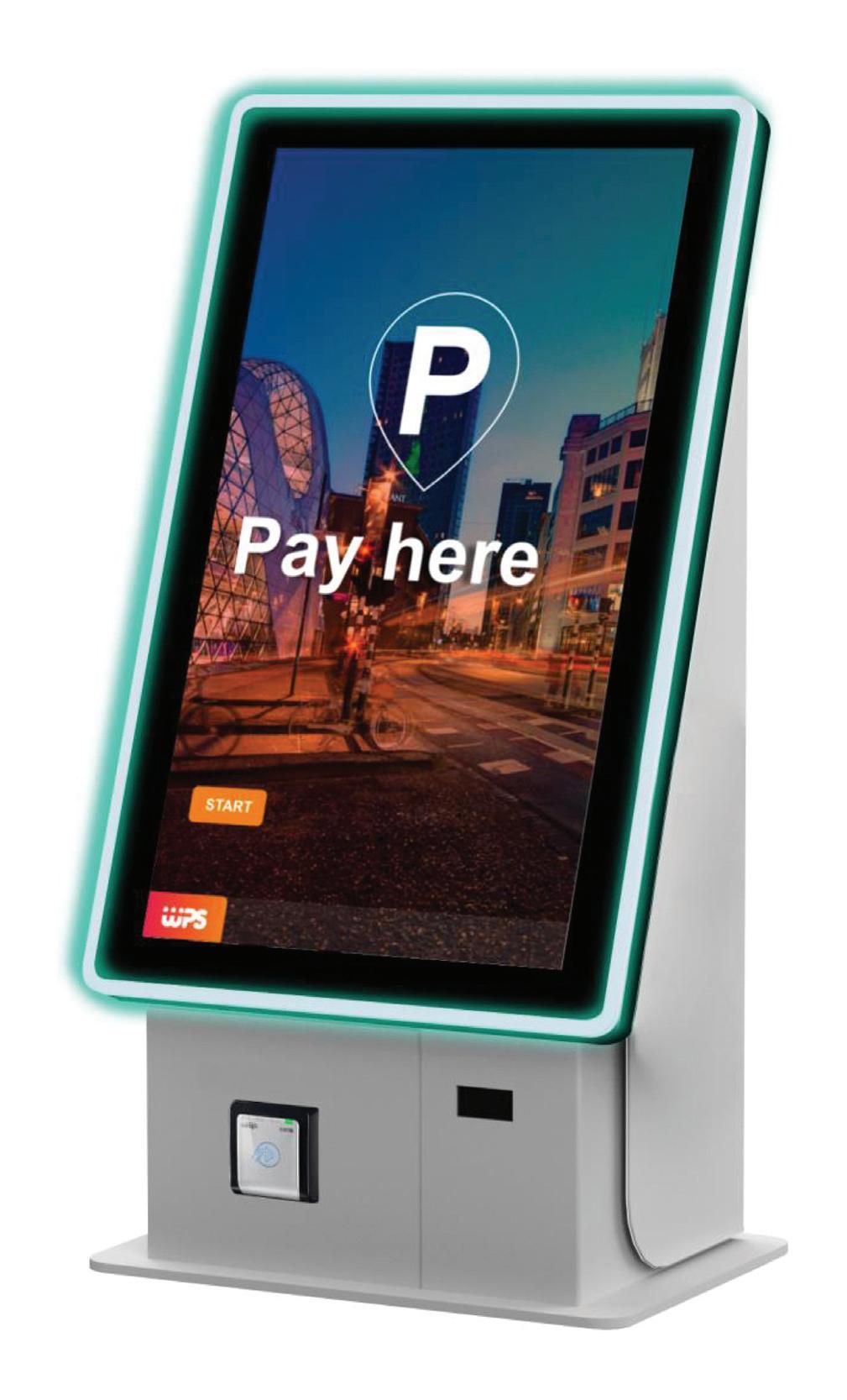
ing, dual-sided, wall-mounted and desk models to give users the ideal solution for any reception, shopping mall or hotel lobby. The ParkID management system is supplemented by the WPS Marketplace, which offers a range of applications.
Dries Calcoen, global product marketing and partnership manager at WPS, said: ‘’The partnership with Prestop is very important to us as it marks the start of connecting third party hardware through the WPS Platform. By expanding our product portfolio with premium kiosk module solutions it offers our customers a suitable solution for every situation.’’
Alexander Aelberts, chief executive of Prestop, said: “We are proud that WPS has selected us as their partner for designing and producing the WPS kiosks worldwide. Especially the wide product range, the IT knowledge and sales support present at Prestop have been decisive in making Prestop a direct worldwide supplier.”
phone bill is already a wellestablished payment method in the UK and worldwide, but we want to bring it to the UK parking and transport markets. Our partnership with ZatPark will help car park operators to make fast, simple, secure payments available for their car park customers, without the need to download an app, preregister for anything or share any bank card details.”
ZatPark has enhanced its partnership with Suilvision, a supplier of high-definition ANPR systems with whom it has been working since 2017 to develop services for shared clients.
ZatPark has completed an integration with Debit My Mobile, a text-based payment solution provider that allows drivers to charge parking fees to their phone bills, an approach known as carrier billing.
The agreement enables ZatPark clients to offer drivers inclusive text-based payment methods in their car parks.
Carrier billing transactions are billed directly to the end user’s mobile phone bill rather than using a debit or card.
Debit My Mobile chief
executive Gary Corbett sees carrier billing as an accessible and inclusive approach as there is no need to share bank card details because the parking fees are charged to the phone bills. The service does not need to be linked to a bank account.
There is also no need to download an app and preregister and, because the transactions are SMS-message, based there no need for a smartphone.
Victoria Hull, head of business development for Debit My Mobile, said: “Charge to

Debit My Mobile’s payment solution specialist Doug Mather added: “We’re really excited to have finalised our integration with ZatPark. The work has been quite simple for our team to complete and the ZatPark team was very helpful along the way. In partnership with ZatPark, we look forward to rolling out the first true textbased ‘charge to phone bill payments’ in the UK.”
ZatPark is a provider of parking management software that helps operators through the automation and systemisation of back office processes. Jono Clark, development technologist at ZatPark, said: “Innovation is central to the way we work and that’s why we’re looking forward to making a success of this integration with Debit My Mobile.”
Their latest collaboration will see ZatPark’s ‘allow list’ function to be employed in conjunction with the MySuilvision back office system. This will enable Suilvision’s ANPR camera technology to provide timed barrier access and real-time allow list checks for access control.
These developments will enable sites to have access control activated on a part-time basis while still allowing free flow enforcement at selected times.
The first application of the hybrid solution has been by BaySentry Solutions at the Sandy Acres campsite in Cornwall.
BaySentry uses a Suilvision Phantom 5X camera to detect approaching vehicles. The resulting number plate capture is then compared to the MySuilvision whitelist database using the ‘allow list’ function on its ZatPark back office system. The vehicle will be allowed through if a match is found.
Richard Taylor, the former deputy registrar at Leicester University, said: “We all recognise it would not have happened without the tireless enthusiasm of Philippa, but equally it would not have happened without the university team. Tension makes a good story but it doesn’t necessarily make it true. If you are going to portray real people, at least involve them. It strikes me as pretty reckless.”
Taylor, who is played by Lee Ingleby, is personally unhappy at how he is portrayed, and is considering legal action against the filmmakers. “I’m surprised to be the villain of the piece. There’s dialogue in there that not only didn’t happen that way, but didn’t happen at all. We always included her, and gave out her number to the press.”
The discovery of the remains of King Richard III beneath a car park in Leicester is the focus of a new film starring Sally Hawkins and Steve Coogan.
Philippa Langley was a member of the Richard III Society. As a committed ‘Ricardian’, she became obsessed with finding the last resting place of the king, who was killed at the Battle of Bosworth in 1485.

Historians long disagreed over the fate of Richard’s missing corpse. Some believed his body had been thrown in the River Ouse, while others suggested it
has been laid to rest in the long lost Greyfriars church.
Langley, played by Hawkins in the movie, worked out that the site of this chapel was now occupied by a car park called, well, Greyfriars. It was Langley who persuaded the city council and the University of Leicester archaeology department to start the dig. Human bones were unearthed and, following DNA studies, they were confirmed as the remains of England’s last Plantagenet monarch.
The Lost King, directed by Stephen Frears, depicts Langley as being sidelined by the academics. Her main supporters are her husband John, played by Coogan. and Richard III himself, in the form of Harry Lloyd.
Langley told The Guardian: “I was sidelined and marginalised. I was hugely vulnerable. Because I’m not a doctor. I’m not a professor. But in the end, I came to find my voice.”
The film’s claims have led to a war of words breaking out between the academics and the filmmakers. The University of Leicester disputes Langley’s claims and that she funded much of the early work. The university says it actually made the first major payment and underwrote the dig research. “No University of Leicester staff were interviewed for the film,” a spokesperson said. “We offered to help the filmmakers and were ignored and have the correspondence to prove it.”

A set of Saxon graves have been unearthed beneath a car park in Croydon. The finds came about as developers worked on a housing development at the site.
In all 18 skeletons were unearthed at the Lion Green Road car park in Coulsdon by an archaeological survey which was ordered by the south London council.
The excavations were carried out by the Museum of London Archaeology (MOLA) for Croydon Council’s development company Brick by Brick.
Excavations carried out in
2021 uncovered 12 burials, with another six being discovered in 2022. Six of the skeletons had been buried with
iron knives in their left hand.
Previous excavations at the site have found Roman burials, an undated dog burial and two
However, Dan Winch, The Lost King’s producer, said the filmmakers had had contact with the university, despite the institution claiming otherwise.
Coogan, who co-wrote the film with Jeff Pope, told BBC Radio 4’s Today programme he believed the university had played things “quite badly”. He said: “Had they at the start been generous towards Philippa, and elevated her to the front and centre position, which is where she deserves to be, this film wouldn't have been necessary. But at every turn they marginalised her, edged her out, because she wasn’t cut from the right cloth.”
The War of the Roses is long over, but the Battle of the Car Park King is only just starting. The Lost King is in cinemas now
disturbed graves.
An archaeological report was submitted to Croydon Council as part of the development after plans were approved in 2019.
The report said: “The finds assemblage from within the exhumation burials at Lion Green Road carry potential in the dating of their contexts and in the wider discussion of Saxon burial practices in the region that will arise from this site.”
The Lion Green Road development, which will be named Red Clover Gardens, is one of the final and largest projects to be completed by developer Brick by Brick.






































